- Nov 21, 2022

How to write a winning 3MT script
That’s how many words are in a typical PhD thesis. Years of gruelling research, sleepless nights, and history-making breakthroughs… culminated into one VERY thick book. To present something of this scale would take you approximately 9 hours. 🤯

But what do you do when you only have 3 minutes? ⏰
Well, that’s exactly what thousands of PhD students worldwide do each year in the 3 Minute Thesis (3MT®) competition. Not only do they explain their super complex research in the time it takes to make a coffee, but they do it in a way that can be understood by a non-specialist audience.
But we know what you’re thinking…
So, how do you even win a competition like that? Well first of all, you’re going to need a 3MT script. And we’re about to teach you how to write a WINNING one. 🏅
Not only that, but this blog post marks the beginning of a multi-part series that will cover all the important aspects of preparing a winning 3MT – from writing a captivating speech, to creating an effective slide, and of course, nailing your delivery.
What is the 3MT competition?
The Three Minute Thesis (3MT®) Competition is an annual public speaking competition, where PhD candidates describe the impact and scope of their research in 3 minutes to a non-specialist audience. It was launched by the University of Queensland in 2008 and has since gained traction in over 85 countries around the world! 🌍
Put simply, it’s a fancy elevator pitch. Just imagine that it’s a really slow elevator.
Like any good competition, the 3MT has some rules. Here’s a run-down of some of the big ones:
Rules of the 3MT® competition:
You must use a single static PowerPoint slide with no transitions or animations.
You are limited to 3 minutes maximum. Competitors exceeding 3 minutes are disqualified.
Presentations are to be spoken word (e.g. no poems, raps or songs)… Sorry to all the aspiring rapper-researchers out there.
You can find a comprehensive list of the rules on the official UQ 3MT website.
Well, now that’s out of the way, let’s get into our tips on how to write a winning 3MT script! In this article, I’ll discuss some strategies that I used to craft my own winning 3MT script, but I’ve also watched lots of other award-winning 3MT presentations and identified some common features they share, so that you don’t have to. 😉
#1 : The hook 🪝
Every great 3MT presentation starts off with an attention-grabbing opener, otherwise known as ‘the hook.’ It’s a storytelling essential, and is undoubtedly one of the most important components of the 3MT script.

One clever way to hook the audience in a 3MT presentation is to start off by asking a question , which creates a sense of open dialogue with the listener. For instance, these 3MT finalists began their presentations by asking:

Full videos: Sarah Mokrzycki | Merryn Baker
You can see how the simple act of asking a question makes us reflect on our own personal views and encourages us to engage with the presentation. 💭 Another way to achieve a similar effect is to begin your talk by prompting the audience to act. An effective example of this is presented here:

Full video: Amanda Khamis
Prompting the listener to act is a powerful way to immerse the audience into a particular scenario by making use of their senses. It can be easily achieved by asking the audience to look around the room, visualise a scene using their imagination, or simply taking a deep breath. 😮💨
Finally, several fantastic 3MT presentations also begin with a hook that startles the reader by making an unusual, interesting, or thought-provoking statement. This can be done numerous ways, such as through the use of:
Oxymoron: A figure of speech that combines two contradicting words (i.e., ‘deafening silence’ and ‘old news’).
Paradox: A self-contradictory statement that may actually be true (i.e., ‘less is more’).
Irony: Use of words to convey the opposite of their literal meaning (i.e., telling a rude customer to ‘have a nice day’).
Here are some good 3MT examples where the presenter has opened with a startling hook:

Full videos: Sophie Jano | Kylie Sturgess
The success of this technique arises from its element of surprise, which keeps the listener intrigued and curious. Basically, the more shocking or unexpected the hook, the better. 😲
However, with all this being said, there’s certainly no ‘right’ or ‘wrong’ way to begin your 3MT, and that’s the beauty of creativity. But in case you’re stuck for ideas, here are a few sentence starters to give you some inspiration for creating a compelling hook for your 3MT script:

Once you’ve got the crowd hooked, it’s a prime opportunity to reel them in for your story. 📖
#2 : Tell a story

If you watch all the award-winning 3MT presentations, you’ll notice that they have one thing in common: they all tell a story. And they do it well.
But how do we turn our own complex, and often niche, research into a compelling story? Well, thankfully, we don’t have to reinvent the wheel. We can stand on the shoulders of SciComm giants... 👣
No one is more of an expert at the ins and outs of storytelling than Dr Randy Olson ; scientist-turned-filmmaker, and co-author of the book Connection: Hollywood Storytelling meets Critical Thinking ( a.k.a. our SciComm holy bible). Many of the principles discussed in this section come straight from this remarkable work, which made it to our top 5 must-read science communication books . 📚
As we know from pretty much every Hollywood blockbuster, all good stories have a beginning, middle, and end. In Connection , Randy further develops this idea by outlining what he calls the ‘ABT Template’, which stands for ‘And, But, Therefore.’ These represent the three key components that make up every good story. We’ve talked about the ABT template before , and how it can be used to elevate your storytelling. But, in case you missed it, I’ll use my own research as an example as we work through this concept.
Typically, in the beginning of a story, there’s some exposition. These are facts that help set the scene and ensure that the speaker and audience are all on the same page (pun intended). 😉 These facts can be connected using the word AND. For example:
“Cancer is deadly and traditional chemotherapy is one treatment option.”
Any statements we connect with ‘and’ are typically things that everyone would agree with, so you can quality-check your ‘and’ section by making sure you agree with all the facts you are connecting.
Okay, so we’ve set the scene. But this isn’t really a story yet, is it? The actual story doesn’t begin until there’s a source of tension or conflict , and the simplest word to make this happen is the word BUT:
“Cancer is deadly and traditional chemotherapy is one treatment option, but it comes with a lot of side effects.”
You can see that the ‘but’ is what makes things interesting. It’s what keeps the audience wanting more and makes them ask “Well, what happens next?”
It doesn’t have to be the word ‘but’ either – there are a lot of words that essentially do the same thing, such as however, although, except , and unfortunately, to name a few… (The thesaurus could be your best friend here). What these words have in common is that they create this critical sense of tension.
Following this, is the outcome , which is where the THEREFORE comes in.
“Cancer is deadly and chemotherapy is one treatment option, but it comes with a lot of side effects. Therefore , in our research, we load these drugs into tiny carriers called nanoparticles, which can help to reduce their adverse effects.”
‘Therefore’ is the word that brings everything together. It marks the beginning of a journey of discovery, which eventually leads to the resolution.
You can see how, by simply including these three key words: and, but and therefore , we have generated the foundations of a good story. Your 3MT script will obviously need to be longer than two sentences, but the ABT template provides a useful scaffold that you can build from to ensure that your story is compelling. If you’re interested in reading more on the ABT template and how it can be utilised, make sure to give Connection a read. 📖
To help you shape your story using the ABT template, here are some questions you can aim to answer in the beginning, middle, and end of your 3MT script:

Hopefully this outline can help you create a captivating and persuasive story to communicate your research effectively. Because, in the wise words of Dr Randy Olson, “Tell a good story and the whole world will listen.”
So, we’ve got our story. But what other strategies can we use to make it a little more interesting? Let’s unpack our storytelling toolkit to see how we can spice things up. 🌶
#3 : Your storytelling toolkit: analogies, humour & creation of a character

In addition to using the ABT template to write a compelling narrative structure, there are also several other tools that you can use to connect with your audience and make your story as easy to understand as possible.
One powerful way to do this is to relate your research to a more common experience by using an analogy . Analogies allow us to compare similarities between two seemingly different things. For instance, when I did the 3MT, I used an analogy to compare nanoparticles – a topic that’s not very common – to cars, something that almost everyone is familiar with:

Full video: Cintya Dharmayanti
As you can see, this works because the analogy serves to provide a simpler, more easily understood explanation using concepts and examples from everyday life. 🚗
Besides analogies, another useful tool to create a captivating story is the use of humour . Because who doesn’t like a good laugh, right? 😂 Comedic relief can help you create a bond with the listener and provide some emotional reprieve for what may otherwise be a serious presentation.
Humour is used well in this winning 3MT presentation:

Full video: Trevyn Toone
In this example, humour helps to keep us engaged with the presentation and gives us a good impression of the presenter. However, some care does need to be taken with the use of humour, so as to not devalue the presentation. Don’t worry if you’re not a comedian though (or if your research topics are too grim to joke about), there are still other effective ways to make your story shine.

Some of the most immersive 3MTs are those that introduce a character , fictional or not, and follow that character’s story. This is a particularly useful tool if your research involves a topic that strikes a strong emotional response. The following example executed this well, where the speaker refers to a photo of an adorable young infant with a feeding tube:

This is so effective because it encourages us to empathise with the character and persuades us to see the importance of the presenter’s research. Whether it’s analogies, humour, or the creation of a character, there are lots of ways to make your story relatable and more easily understood.
Now that we’ve got some ideas from our storytelling toolkit, let’s move on! 🙌
#4 : Goodbye technical jargon 👋

Imagine being in a different country, where you don’t speak the native language. You’re chatting with a local, but they can’t speak your language very fluently. The conversation is interspersed with foreign words that you can’t quite understand, so the meaning of the exchange ultimately becomes lost.

That’s what it’s like trying to understand complex research when it’s filled with terminology and jargon only an expert in that field would know. 🤓
Remember that the 3MT is for a non-specialist audience, which is very different to a conference presentation that’s mostly filled with experts in the field. As scientists, it’s our job to make sure that we are speaking the same language as our audience, and for the 3MT, that means avoiding the use of language that’s too niche or technical. We can still explain complex concepts using language that’s easy to understand!
But how do you do that, when you’ve spent years in academia doing the opposite? 😅
The best way to avoid the overuse of jargon is to simply seek the help of a non-specialist. Ask someone that’s not in your field of research to listen to your presentation and provide feedback. Perhaps this is a friend, family, or fellow student from a completely different department. Does your story make sense to them? If not, it probably won’t make sense to many people in the 3MT audience.
I remember when I was preparing my 3MT script, I went through this exact process! Reading it aloud to my mum, sister, and pretty much anyone who would listen, to make sure each sentence was easy to follow and understand. It’s actually what helped me come up with the idea of the car- analogy in the first place! So, keep iterating and tweaking your presentation until it makes sense to the mailman, the bus driver, and the neighbour down the road.
Also, make sure to keep your story focused on the big picture, rather than getting bogged down in the details and data. Not only will this make your presentation hard to understand, but it’s also more likely to make it B.O.R.I.N.G. and lead to blank stares !
When you’ve ticked all these boxes – great! You’re ready to move on.
#5 : The finisher: Coming full circle
Good job! You’re almost done. Time to add the finishing touch. We can all agree that a strong finish makes for a more memorable presentation. One trend that’s very common amongst winning 3MT presentations is the way that they finish: by bringing their story full circle. As the name suggests, this essentially means that the presenter refers back to the beginning of the story, especially if a particular character, scenario, or analogy is used.

For instance, in this winning 3MT example, the presentation begins with:

Then, as the presentation comes to a close, the final segment ends by referring back to the opening sentence:

Full video: Matthew Shaw
By bringing the story full circle, the audience gains a sense of satisfaction and closure as the cycle returns to its beginnings and the status quo is restored.
Take-away messages
The thought of distilling years of research down to just 3 minutes can be daunting, especially when it’s a competition. 😰 However, if you:
Create an attention-grabbing hook
Tell a captivating story using the ABT template
Use tools such as analogies, humour, and characters
Get rid of technical jargon, and
Bring your story full circle
You’re well on your way to writing a fantastic 3MT script! So, what are you waiting for? Let’s tell your story. Time is ticking. 😉⏰
And remember – if you want to further master your storytelling and public speaking skills, we’d love to show you how in one of our online or in-person science communication workshops .
Feel free to contact us to find out more!
Cintya Dharmayanti
Dr Juan Miguel Balbin
Dr Tullio Rossi
Illustration
Alvin Yanga

Related Posts
What does it mean to be a science communicator?
5 tips for improving your public speaking skills as a researcher
How to write effective analogies for communicating research

Samantha O'Sullivan (Physics / African American Studies)
Gullah Physics: Challenging English Language Hegemony in Science
Second prize expand_more
Sahar Mariam Mohammadzadeh (Government)
The Impact of Twitter on the Supreme Court
Third prize expand_more
Stephanie Alderete (Psychology)
Preschoolers' Ability to Think about Alternative Possibilities
Finalists expand_more
Alex Grayson (Molecular & Cellular Biology)
Comparing Fox and Human Brain Connectivity Patterns
Javin Pombra (Computer Science)
Unraveling the Black Box: Explainability for Artificial Intelligence in the Twenty-First Century
Zelin Liu (Classics / History)
Using the Past to Define Group Identity
Jerrica Li (Comparative Literature)
Diaspora: A Genre for This New Planetary Reality
Jahnavi Rao (Government)
The Spillover Potential of a Nudge
Daiana Lilo (Government / Data Science)
A Great Personality: How Different Characteristics Can Predict Supreme Court Decisions
Cookies on our website
We use some essential cookies to make this website work.
We'd like to set additional cookies to understand how you use our site. And we'd like to serve you some cookies set by other services to show you relevant content.

- Accessibility
- Staff search
- External website
- Schools & services
- Sussex Direct
- Professional services
- Schools and services
Sussex Researcher School
- Researcher development
- Three Minute Thesis
Preparing your 3MT presentation
- Back to previous menu
- Eligibility, Rules and Judging Criteria
- Sussex 3MT 2023
- Sussex 3MT 2022
- Sussex 3MT 2020
- Sussex 3MT 2019
- Sussex 3MT 2018
- Sussex 3MT 2016

NOTE: Familiarise yourself with the 3MT rules and judging criteria before starting your preparation. This guidance is taken from the University of Queensland's official 3MT competitor resources .
Even the world’s best public speakers prepare before important presentations. To assist you with your preparations, please find a few suggestions below that will help you in writing your presentation, creating your slide and practising your verbal presentation.
Drafting your 3MT
Write for your audience The judges will look for evidence that you can explain your research to a non-specialist audience. You may like to:
- avoid jargon and academic language
- explain concepts and people important to your research - you may know all about Professor Smith’s theories but your audience may not
- highlight the outcomes of your research, and the desired outcome
- imagine that you are explaining your research to a close friend or fellow student from another field
- convey your excitement and enthusiasm for your subject
Tell a story
- You may like to present your 3MT as a narrative, with a beginning, middle and end.
- It’s not easy to condense your research into three minutes, so you may find it easier to break your presentation down into smaller sections.
- Try writing an opener to catch the attention of the audience, then highlight your different points, and finally have a summary to restate the importance of your work.
Have a clear outcome in mind
- Know what you want your audience to take away from your presentation.
- Try to leave the audience with an understanding of what you’re doing, why it is important, and what you hope to achieve.
- Proof your 3MT presentation by reading it aloud, firstly to yourself and then to an audience of friends and family.
- Ask for feedback.
- Ask your audience if your presentation clearly highlights what your research is about and why it is important.
Creating your 3MT slide
Before you start work on your slide, you should take the following rules into account:
- one single static PowerPoint slide is permitted;
- no slide transitions, animations or 'movement' of any description are permitted;
- your slide is to be presented from the beginning of your oration; and
- no additional electronic media (e.g. sound and video files) are permitted.
Suggestions
You may like to consider some of the following suggestions:
- Less is more : text and complicated graphics can distract your audience – you don’t want them to read your slide instead of listening to your 3MT.
- Personal touches : personal touches can allow your audience to understand the impact of your research.
- Creativity drives interest : do not rely on your slide to convey your message – it should simply complement your oration.
- Work your message : think about how your slide might be able to assist with the format and delivery of your presentation – is there a metaphor that helps explain your research?
- An engaging visual presentation can make or break any oration, so make sure your slide is legible, clear and concise .
Practising your 3MT presentation
Practice, practice, practice Feeling nervous before you present is natural, and sometimes a little nervousness can even be beneficial to your overall speech. Nonetheless, it is important to practice so you can present with confidence and clarity. Practicing will also help you gauge the timing of your 3MT so that you keep within the time limit.
Vocal range
- Speak clearly and use variety in your voice (fast/slow, loud/soft).
- Do not rush - find your rhythm.
- Remember to pause at key points as it gives the audience time to think about what you are saying.
Body language
- Stand straight and confidently.
- Hold your head up and make eye contact.
- Never turn your back to the audience.
- Practise how you will use your hands and move around the stage. It is okay to move around energetically if that is your personality, however it is also appropriate for a 3MT presentation to be delivered from a single spot on stage.
- Do not make the common mistakes of rolling back and forth on your heels, pacing for no reason or playing with your hair as these habits are distracting for the audience.
Record yourself
- Record and listen to your presentation to hear where you pause, speak too quickly or get it just right.
- Then work on your weaknesses and exploit your strengths.
Look to the stars!
- Watch your role models such as academics, politicians and journalists, and break down their strengths and weaknesses.
- Analyse how they engage with their audience.
- Visit the Queensland 3MT website , the Vitae 3MT webpages or search YouTube to view presentations from previous 3MT finalists.
- While there is no dress code, if you are unsure of how to dress you may like to dress for a job interview or an important meeting. It is important that you feel comfortable so you can focus on your presentation.
- If you are presenting on a stage that has a wooden floor, be aware of the noise your footwear might make.
- Do not wear a costume of any kind as this is against the rules (as is the use of props).
Further resources
There are many resources available online for further help. Useful ones might include:
Presenting your research effectively and with confidence - By previous 3MT finalists (Taylor & Francis resource)
How a competition changed my academic life - By Jamie Khoo, 2018 UK People's Choice winner
Is it worth doing the three minute thesis? - By Mary Woessner, Victoria University
How to win the 3 minute thesis - By Dr Inger Mewburn (aka @thesiswhisperer)
Making the most of your 3 minutes - Simon Clews, University of Melbourne
Talk nerdy to me - Melissa Marshall's TED talk
Vitae's 3MT webpages
These guidance pages are part of the University of Queensland's official 3MT competitor resources
Copyright © 2024, University of Sussex

Want to create or adapt books like this? Learn more about how Pressbooks supports open publishing practices.
22 The 3 Minute Thesis
Read time: 2 minutes
This chapter will provide an overview of the 3 Minute Thesis oral presentation format.
Sections in this chapter
What is it.
- 3MT examples

The three-minute thesis (3MT) is a new format of research presentation that builds on the classic “elevator pitch”. The challenge in this type of presentation is to explain your research to an intelligent non-specialist audience in under 3 minutes with limited visual aids. Often there are specific rules for the visual aid: a single 4:3 slide, no animations or video, and no props.
For a successful 3MT talk, you need to follow completely different rules from normal scientific presentations. You can skip common things like introducing yourself, thanking all your lab mates and colleagues, or funding. You typically don’t show data unless it is presented in a very simple figure.
Because of the challenge involved with presenting years of detailed research in only three minutes, Universities hold cross-faculty 3MT competitions. The first was founded by the University of Queensland, Australia, where you can find many great resources and videos .
The tips below were adapted from “10 Hints for Improving Presentations for the Three Minute Thesis” by Danielle Fischer at Charles Darwin University ( Full PDF here ):
- Don’t introduce yourself, don’t do acknowledgements, don’t show data.
- Start by introducing how your research relates to the bigger picture. Try to think of why any person might be interested in your work.
- Only include relevant things on your slide and make sure images are good quality. Carefully design your slide, don’t overcrowd it or use too much colour.
- Use simple and familiar analogies.
- Speak with an excited and engaged manner.
- Don’t wear anything distracting.
- Use body language: smiling, gestures, movement, and eye-contact.
- Finish by bringing the audience back to the big picture.
- Practice and get feedback from a wide variety of people.
- Use your time, but don’t go over it.
These are some 3MT slides made by previous CHEM 803 students.
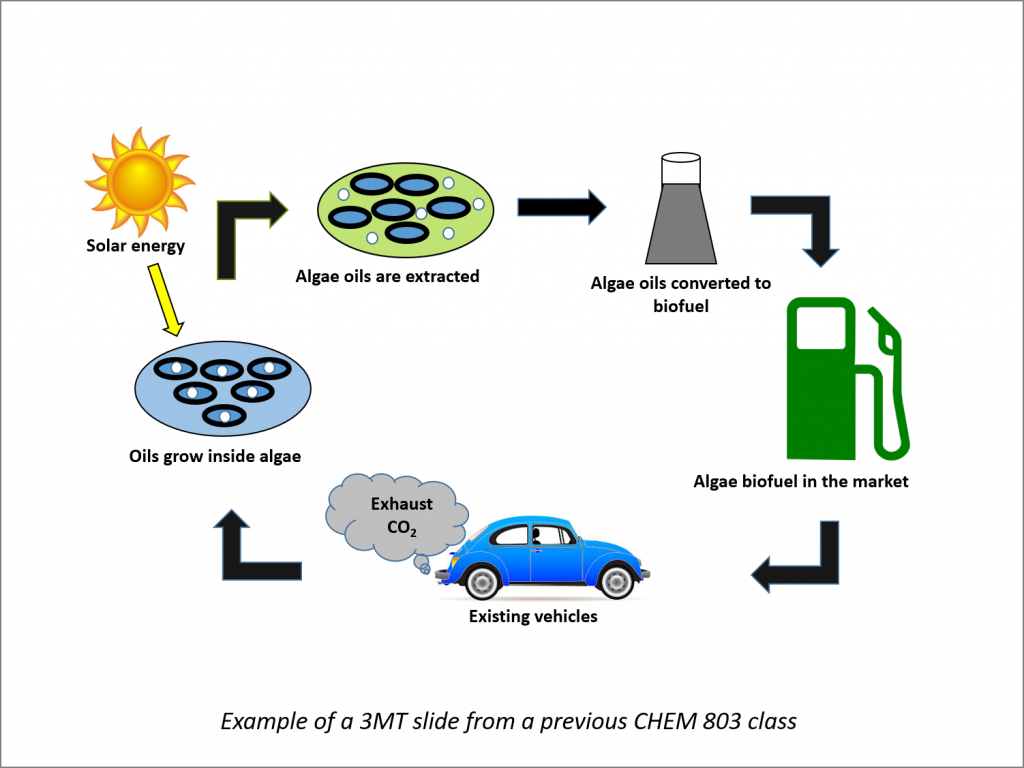
There are many resources online about preparing a 3MT presentation. Below are some links to helpful videos, award-winning 3MT talks, and the many resources provided by Queen’s University.
Helpful Videos
These videos were prepared by are owned by Australian National University.
3MT: three tips to help you prepare a winning presentation
3MT: the three most common mistakes
Award-winning 3MT
These are videos of some award-winning 3MT talks. The first one has the best title, it’s simple and concise!
Wind turbines and climate change – Rosemary Barnes
Hypoxia-activated pro-drugs: a novel approach for breast cancer treatment – jasdeep saggar, the development of anti-body-drug conjugate to specifically target and soften the crystalline lens in vivo – gah-jone won.
Check out the Queen’s University 2020 Competition results, where you’ll find two award-winning 3MT talks from our Chemistry Department by Morgan Lehtinen and Alastair Kierulf. [ In the video at this link, click “Playlist” to find their talks ]
Principles of Scientific Communication Copyright © 2020 by Amanda Bongers and Donal Macartney is licensed under a Creative Commons Attribution-NonCommercial 4.0 International License , except where otherwise noted.
Share This Book
Utility Links
Utility navigation.
- New Students
- Graduate Organizations
- Graduate Alumni

Secondary Nav Penn GSC
- Your Space on Campus
- Support Our Work
Primary Nav Penn GSC
- Resource Guide
- Funding and Finances
- Navigating the Academy
- Graduate Student Life
Drawer Menu Penn GSC
- Back to main menu
- Join Our Team
- Accessibility
- Grad Center Spaces
- Reserve a Room
- Building Hours
- Mission and Vision
- Engage with Us
- Grad Center Advising and Support
- Penn Grad News
- About & Submissions
- New Student Orientation Hub
- For International Students
- Online Sessions for New Students
- Student Accounts & Technology
- Diversity, Equity, and Inclusion
- Campus Activities
- Graduate Student Groups
- Conduct and Safety
- Living in Philadelphia
- Safety and Campus Conduct
- Alumni Resources
- Graduate Grants
- Graduate Emergency Fund
- Insurance Grants for PhD Students
- Dissertation Boot Camp
- Writing Groups
- Writers Rooms and Retreats
- GAPSA-Provost Awards
- About the Fontaine Society
- Resources for Current Fellows
- Fontaine News
- Teaching and Mentoring
- Resources & Support
- Language Programs
- Community Impact Fund
- Graduate Leadership Awards
Penn Three Minute Thesis (3MT)
Basic page sidebar menu penn gsc.
Three Minute Thesis (3MT®) is a competition for doctoral and research students to develop and showcase their research communication skills through brief, 3-minute presentations.
Penn's annual 3MT competition is sponsored by the Office of the Vice Provost for Education, with co-sponsorship and support from Career Services, the Graduate Student Center, and GAPSA.
Penn 3MT is a University-sponsored speaking competition designed to showcase graduate student research in three-minute talks to a general audience. This is a terrific opportunity for graduate students engaged in substantive original research to develop communication skills and share their work with faculty, students, and staff from across the University.
- 3MT Information Sessions : November 2023 & January 2024
- Research Communications Workshops : October - November 2023 & February 2024 (optional)
- Practice and Feedback Sessions: February 2024 (optional)
- First Round Video Submissions Due: Saturday, March 2, 2024
- Finalists announced: March 7-8, 2024
- Finalist Feedback Sessions: March 8-21, 2024
- In-person Competition : Friday, March 22, 2024
In addition to bragging rights, a prize of $1000 will be awarded to the first-place winner and $500 to both the second-place and audience choice winners. Winners will also have the opportunity to participate in regional and national 3 Minute Thesis competitions!
Meet the Finalists & Winners!
First place, $1000, kritika jha.
Kritika is a material chemistry Ph.D. student at the SAS and has dedicated her research to sustainable and intelligent packaging solutions. She is also a great fan of cooking, so she’s always cooking up a storm both in the lab and the kitchen, with a mission to whip up eco-friendly packaging solutions. So, just think of her as a chef-scientist, where her ingredients aren't just spices and veggies, but also the stuff that could make tomorrow's packaging as compostable as an apple core, with a sprinkle of creativity and a dash of science. Now she’s going to tell you more about all that in her talk title “Nanosuperheroes: Who Can See the Unseen Dangers”
Second Place, $500, Grace Simon
Grace is a PhD Candidate in the Management Department. Before embarking on her PhD journey, Grace spent five years working in the financial services industry. From supporting employees through bank robberies to leading a crisis communications team during the pandemic, Grace realized the central role of emotions in the workplace. In her research, she explores when and why supportive intentions at work can go right and wrong. When she's not working on research, you can find her searching for the best ice cream in Philadelphia or perfecting her soft pretzel recipe. Now she’s going to tell you about her research in her talk titled “Putting Feelings into Words”
Audience Choice, $500, Talayah Johnson
Talayah is Bioengineering Ph.D. student here at the University of Pennsylvania. Her journey started at Penn State University where she received her B.S in biology and Masters in biomechanics. Outside of research she enjoys volunteering at Philadelphia high schools as a way of encouraging minority students to pursue STEM degrees. Now she’s going to tell you about her research in her talk titled “The Tendon’s Achilles Heel: How Reduced Loading Affects Limb Growth”
Shelvey Swett
Shelvey is a second year PhD student in the Chemical and Biomolecular Engineering department. Her work focuses on carbon capture and storage. Outside of research, Shelvey loves reading, watching video essays, and doing hot yoga. Now she’s going to tell you about her research in her talk titled ‘Carbon capture? I hardly know her! Critical Mineral Supply and Carbon Dioxide Storage from Mining Waste’
Maya Moritz
Maya is a PhD student in the Criminology department at Penn. She grew up in New Jersey and studied labor and historical economics in Scotland, Canada, and Germany. During her studies, she listened to way too many true crime podcasts and, as a result, decided to return home and examine a different labor market- crime. As a PhD student in criminology she tries to keep her work on the brighter side by studying the crime-fighting effects of art, lighting, and the power of community. Now she’s going to tell you about her research in her talk titled “A Picture Worth A Thousand Words: The Effects of Murals on Crime ”
Chris Johnson
Chris is a doctoral candidate in chemical and biomolecular engineering, with a focus on deciphering the physics behind new materials for energy technology. He has had work published in scientific journals such as Polymer, Advanced Materials Interfaces, and Chemical Communications. He was the 2020 winner of the Elda Wollaeger Gregory poetry award at the University of Delaware, and spends his free time playing with his cat Poe. Now he’s going to tell you about his research in his talk titled “Mission Ion-possible Charges in Motion"
Natalia (Nati) Aponte Borges
Natalia is a graduate researcher, bilingual STEM educator, and artist. She obtained her B.S. in Biology from the University of Puerto Rico, Río Piedras and is currently a Biology PhD Candidate in the Schmidt Lab. She is broadly interested in the neurobiology of behavior, known as neuroethology. Her work focuses on the neural mechanisms that control courtship behaviors in songbirds. She studies brown-headed cowbirds, which have an elaborate song and display during courtship. Outside of research, she is passionate about community, science literacy, disability justice, and teaching. Along with birds, she loves photography, sewing, and going to the beach. Now she’s going to tell you about her research in her talk titled “The Neural Command of Courtship: How the Bird Brain Orchestrates an Elaborate Wingspread”
Pulkit Khandelwal
Pulkit is a 5th year PhD student in the department of Bioengineering. Previously, he completed his masters in computer science at McGill University in Montreal. Pulkit's research interests lie in biomedical image analysis using artificial intelligence and shape analysis to understand how neurodegenerative diseases, such as Alzheimer’s, spread in the brain using postmortem human brain MRI. In his spare time, he likes to read poetry, literature, listen to Greek mythology podcasts, nerd out on coffee, enjoy foreign language independent movies, and lately he has been interested in rare books and book binding! Now he’s going to tell you about his research in his talk titled “Alzheimer's disease: cutting the brain open, literally!”
To enter, students must register below and submit a video of their three-minute talk to Penn 3MT (details below) by Saturday, March 2. From those first-round submissions, up to 10 finalists will be chosen to compete in the campus-wide, live competition on Friday, March 22.
Register for Round 1 Video Submission
The 3MT competition will teach you how to communicate effectively to specialists and non-specialists alike, preparing you to present your research at scholarly conferences and to take part in both academic and professional job markets.
Professional Development: Penn 3MT is a great opportunity for graduate students to practice sharing their original research to general audiences. Participants have the opportunity to attend workshops and receive group and one-on-one coaching to develop oratorical skills, dynamic deliveries, and compelling content when presenting their academic research.
Networking: 3MT participants will have an opportunity to meet and engage with new faculty, staff, and students from across the University.
Impact: Participants have the opportunity to make the importance and relevance of their research visible to a non-specialist audience. Participants can elect to have their presentation shared online, promoting both your own work and the value of graduate student research to a much wider audience.
Prizes: Everyone who submits a video will receive prizes from GAPSA and the Grad Center! Please register at the blue button at the top of the page if you plan on submitting a video so we can collect your contact information. Judges will select a first-place ($1000) and second-place ($500) winner at the live competition. There will also be an audience choice ($500) winner.
Active PhD, Professional Doctorate Research (program composed of at least 2/3 research and eligible for Research Training Program (RTP)), and full-time Masters candidates who have successfully passed their confirmation milestone (including candidates whose thesis is under submission) by the date of their first presentation are eligible to participate in 3MT competitions at all levels. Graduates are not eligible.
Please Note : Students enrolled in any of the following programs are not eligible to enter the 3MT Competition:
Professional Masters
Professional Doctorate (less than 2/3 research)
Entries from all disciplines are welcome and encouraged.
In cases of presentation of a collaborative research project, the presenter’s contribution to the project must be salient and clearly specified.
If you are unsure of your eligibility or would like more information about 3MT, please contact [email protected] . You can also check the Graduate Catalog for your Penn School to see if your program is listed under the PhD and Research Master's Programs.
To enter, you must submit a three-minute video of your presentation by 11:59 p.m. (local time) on March 2, 2024.
Please register at the blue button at the top of the page if you are interested in participating . Be sure to read through the Rules and Guidelines also before submitting your videos!
Competition Process
Students may submit their slide and video anytime before Saturday, March 2, 2024 for feedback. You can also request a 1:1 session during this time for immediate feedback or to go over your presentation with the Associate Director.
Research Communications Workshops offered by the Graduate Student Center will occur October - November and January - February. See our Events page for details.
Student videos submitted by the deadline of Satur day, March 2 at 11:59 p.m., EST are reviewed by a panel of staff for compliance with the eligibility requirements.
10 Finalists are selected for the online competition by March 7-8, 2024.
A campus-wide competition between the finalists will be held March 22, 2024. A reception will be held after the competition.
On the basis of these presentations, winners will be selected by the panel of judges and a “people’s choice” by audience members.
Judging and Selection
A panel of non-specialist faculty and staff judges will evaluate student presentations. Presentations will be evaluated based on clarity, comprehension, content, engagement, and communication.
Everyone who submits a video will receive a gift for participating! Please fill out the interest form above if you plan on submitting a video so we can collect your contact information. Judges will select a first ($1000) and second-place ($500) winner at the live competition. There will also be an audience choice ($500) winner.
All decisions of the judging panel are final.
Video submission:
- Your video and slide should be submitted using the button below. Please register at the blue button at the top of the page if you are interested in participating .
- All video files should be named: “Title_of_talk.mp4” or “Title_of_talk.mov”. Please do not include your name or any other identifying information in the name of the video file.
- You do not need to include your slide in your video. A video of you speaking is enough. You will upload your slide alongside your video.
- At the very beginning of your video, please state your full name, graduate program, and the title of your presentation. The time it takes to do this will not be counted against the three minutes to present your research.
- You will not be judged on your skills as a videographer, and you do not need to use professional video equipment. As long as the judges can see you and the audio is clear and understandable, that is sufficient. You can record yourself using the Panopto interface in Canvas. You can also record yourself in Zoom. You may ask a friend or colleague for help creating your video, or you can get assistance and borrow equipment from the Vitale Digital Media Lab . You can also follow these tips for recording a presentation in Zoom . Here is one demonstrated on a Mac .
Visual submission :
- Presenters may use a single image or static PowerPoint slide (no Prezi or other presentation formats) to enhance their presentation.
- Students must create their slides themselves – they cannot ask someone else to design the slides. Use of PowerPoint templates is allowed.
- Slides can include visual elements (charts, visualizations, photos, clip art, etc.) created by someone other than the student, as long as the slide credits the original creator.
- Embedded audio, animations, and/or video clips (including but not limited to .gif, .avi, .mp4, .mp3, and .wmv file types) are NOT permitted.
- Powerpoint slides should be named "Title_of_talk.ppt". Please do not include your name or any other identifying information in the name of the PowerPoint file.
Powerpoint slides and videos can be uploaded below. If you are having difficulty, please upload it to Microsoft, Box, or Google Drive and email jomcb at upenn.edu the link to download.
Upload Your Video & Slide
Length and Timing: Presentations should be a maximum of three (3) minutes in length, commencing from the moment the speaker starts the presentation through movement or speech.
- The presentation begins at the moment the speaker engages with the audience (if they start with a hand clap, a gesture, or any other such engagement, prior to speaking, the clock begins at that time; if there is no such engagement the clock starts when the student begins speaking).
- If the speaker continues past three minutes, points will be deducted from the final score, beginning with one point at 3:03, and one point every two additional seconds thereafter.
- No props of any kind are permitted, and notes cannot be used during the presentation.
Want some help getting started? In need of Inspiration? Check out the resources below!
3MT® Resources
- Three-Minute Thesis Showcase : Watch winning 3MT presentations from around the world.
- Three Tips to Help You Prepare a Winning Presentation
- 3MT: The Three Most Common Mistakes
- Sample 3MT Coaching Session
Past Penn 3MT ® Competitions and Workshops
Research Communications Workshops
Additional Resources
- Nature MasterClass: Effective Science Communication (PennKey login required)
- Alda Center for Communicating Science Creating Connections Workbook
- XKCD Simple Writer
- Dejargonizer
- TED Talks : Short talks on “ideas worth spreading.”
- PhD Comics Two-Minute Thesis Competition
- Berkeley Grad Slam Competition
Graduate Student Center University of Pennsylvania 3615 Locust Walk Philadelphia PA 19104 215-746-6868
Footer Menu
- Penn Provost Education Division
- Valuing Graduate Students
Graduate School
- Request Information
- Three-Minute Thesis
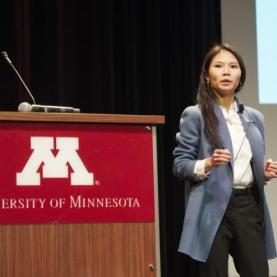
What is the 3MT?
An 80,000 word thesis would take 9 hours to present. The 3MT time limit ... 3 minutes.
- The 3-Minute Thesis (3MT®) is a research communication competition that challenges students to communicate the significance of their projects without the use of props or industry jargon, in just three minutes.
- Originally established by the University of Queensland (UQ) in 2008 , the competition challenges research students to communicate the significance of their projects in just three minutes, with the aid of a single, static slide.
3MT develops academic, presentation, and research communication skills and supports the development of research students' capacity to quickly explain their research in a language appropriate to a non-specialist audience leaving them wanting to know more.
Competitions at the University of Minnesota

Collegiate-level 3MT Competitions
- Inquire with your Graduate Program Coordinator (GPC) to find out if your college hosts a 3MT competition.
- Collegiate-level 3MT winners advance to the University-wide competition.
- All collegiate-level participants receive a Maroon Digital Badge from the Graduate School.
University-wide 3MT Competition
- The Graduate School hosts a University-wide competition held every November .
- All active graduate students who have advanced from their collegiate competition are eligible.
- Previous 3MT winners (first prize, runner-up, and people's choice) are not eligible to compete a second time.
- The 1st place winner advances to a 3MT competition hosted every March by the Midwestern Association of Graduate Schools (MAGS).
- All finalists may be invited to present to the University's Board of Regents.
- All University-wide competitors receive a Gold Digital Badge from the Graduate School.
3MT Competition Rules
- Single static PowerPoint slide. No slide transitions, animations, or “movement” of any description are allowed. The slide is to be presented from beginning of oration.
- No additional electronic media (e.g. sound and video files) are permitted.
- No additional props (e.g. costumes, musical instruments, lab equipment) are permitted.
- Presentations are limited to 3 minutes maximum, and participants exceeding 3 minutes are disqualified.
- Presentations are to commence from the stage.
- Presentations are to be spoken word (e.g. no poems, raps, or songs).
- Presentations are considered to have commenced when a presenter starts her presentation through either movement or speech.
- The decision of the adjudicating panel is final.
3MT Preparation Resources
- Prepare with the Graduate School's 3MT e-course
- 2023 - Watch competition in its entirety
Who can I talk to about 3MT?
Please contact Dr. Noro Andriamanalina, Assistant Vice Provost, Graduate Student and Postdoctoral Initiatives: [email protected]
- About the Grad School
- Staff Directory
- Office Locations
- Our Campuses
- Twin Cities
- Mission & Values
- Strategic Plan
- Policies & Governance
- Graduate School Advisory Board
- Academic Freedom & Responsibility
- Academic & Career Support
- GEAR 1 Resource Hub
- GEAR+ Resource Hub
- Ask an Expert
- Graduate School Essentials
- Transferable Skills Checklist
- Grad InterCom
- First Gen Connect
- Advising & Mentoring
- Individual Development Plan (IDP)
- Application Instructions
- Application Fees
- Big 10 Academic Alliance Fee Waiver Program
- Application Status
- Official Transcripts & Credentials
- Unofficial Transcripts & Credentials
- Recommendation Letters
- International Student Resources
- Admissions Guide
- Change or Add a Degree Objective
- Readmission
- Explore Grad Programs
- Preparing for Graduate School
- Program Statistics
- Recruiting Calendar
- Funding Opportunities
- Prospective & Incoming Students
- Diversity of Views & Experience Fellowship (DOVE)
- National Science Foundation Graduate Research Fellowship
- Current Students
- Banting Postdoctoral Fellowship Program
- Distinguished Master's Thesis Competition
- Diversity Predoctoral Teaching Fellowships
- Doctoral Dissertation Fellowship
- Excellence in Teaching Award
- Fulbright U.S. Student Program
- Graduate SEED Awards
- Harold Leonard Memorial Fellowship in Film Study
- Interdisciplinary Doctoral Fellowship
- Judd Travel Grants
- Louise T. Dosdall Endowed Fellowship
- Mistletoe Fellowship
- Research Travel Grants
- Smithsonian Institute Fellowship
- Torske Klubben Fellowship
- Program Requests & Nominations
- Bridging Funds Program
- Best Dissertation Program
- Co-Sponsorship Grants Program
- Google Ph.D. Fellowship
- National Science Foundation Research Traineeship
- National Science Foundation Innovations in Graduate Education Program
- Training Grant Matching Funds
- Fellowship Dates & Deadlines
- Information for Staff & Faculty
- About Graduate Diversity
- Diverse Student Organizations
- McNair Scholars Resources
- About the Community of Scholars Program
- Graduate Recruitment Ambassadors Program
- Community of Scholars Program Writing Initiative
- Faculty & Staff Resources
- Diversity Recruitment Toolkit
- Summer Institute
- Diversity Office Staff
- What's Happening
- E-Publications
- Submit Content
- News Overview
- Events Overview
Wayne State University
Graduate school graduate school, three-minute thesis (3mt) guidelines.
Three-Minute Thesis (3MT®) is a research communication competition developed by The University of Queensland in 2008. Participants present their thesis work in a short presentation using a single slide. The competition challenges students to distill their research ideas and discoveries into a concise, compelling presentation that can be understood by a general, non-specialist audience.
The 2024 3MT will take place during the Feb. 28, 2024, Graduate Research Symposium. After three years in a virtual environment, the GRS will return to its original in-person format in 2024 at the Student Center. GRS attendees will score the presentations and select a winner, who will move on to compete at the Midwestern Association of Graduate Schools April 4-6, 2024 in Clayton, MO.
The submission window is now closed.
Eligibility
The competition is open to Ph.D. students completing a thesis or a dissertation.
- Participants can use only one static PowerPoint slide. (No transitions, animations, or movement are allowed.)
- No additional electronic media are allowed.
- No props (e.g., costumes, musical instruments, models, laboratory equipment) are permitted.
- Presentations are limited to three minutes; competitors who exceed the time limit will be disqualified.
- Presentations must be spoken word. No poems, raps, or songs are allowed.
- Participants must deliver their remarks from the stage.
- Presentations are considered to have begun when participants begin speaking or moving.
- The winners of the 3MT competition at the GRS will be selected by popular vote and the decision will be final.
Presentations will be judged by the participating audience. Every member of the audience will vote for their top three presentations according to the criteria listed below. (Each audience member can vote only once for a specific competitor.) The scores from all audience members will be compiled to determine the winners.
Comprehension and content
- Did the presentation help the audience understand the research?
- Was the thesis topic and its significance communicated in language appropriate to an intelligent but non-specialist audience?
Engagement and communication
- Did the oration make the audience want to know more?
- First place - $1000 plus the registration fee to attend the Midwestern Association of Graduate Schools competition
- Second place - $500 award
- Third place - $300 award
- 3MT Competitor Guide by The University of Queensland (2017)
- 3MT: The Three Most Common Mistakes , a video featuring Inger Mewburn, director of research training at Australian National University
- 3MT: Three Tips to Help You Prepare a Winning Presentation , video featuring Rosanna Stevens, 2014 winner of the Australian National University 3MT competition
- How to Talk about Your Thesis in Three Minutes , a Prezi presentation by Inger Mewburn (2012)
- Making the Most of Your Three Minutes , a guide by Simon Clews
- Winning Tips for Preparing a Three-Minute Thesis Presentation , video by Sean McGraw
Presentations
- 2017 People's Choice Award winner, Nisansala Muthunayake, Chemistry
- 2017 First Place (tie), Xavier Swiecki, Art and Art History
- 2017 First Place (tie), Daniel Harrison, History
- View 3MT presentations on the University of Queensland's 3MT website
At home, abroad, working, interning? Wherever you are this summer, contact OCS or make an appointment for a virtual advising session. We are available all summer!
- Undergraduates
- Ph.Ds & Postdocs
- Prospective Students & Guests
- What is a Community?
- Student Athletes
- First Generation and/or Low Income Students
- International Students
- LGBTQ Students
- Students of Color
- Students with Disabilities
- Student Veterans
- Exploring Careers
- Advertising, Marketing & PR
- Finance, Insurance & Real Estate
- General Management & Leadership Development Programs
- Law & Legal Services
- Startups, Entrepreneurship & Freelance Work
- Environment, Sustainability & Energy
- Media & Communications
- Policy & Think Tanks
- Engineering
- Healthcare, Biotech & Global Public Health
- Life & Physical Sciences
- Programming & Data Science
- Graduate School
- Health Professions
- Business School
- Meet with OCS
- Student Organizations Workshop Request
- OCS Podcast Series
- Office of Fellowships
- Navigating AI in the Job Search Process
- Cover Letters & Correspondence
- Job Market Insights
- Professional Conduct & Etiquette
- Professional Online Identity
- Interview Preparation
- Resource Database
- Yale Career Link
- Jobs, Internships & Other Experiences
- Gap Year & Short-Term Opportunities
- Planning an International Internship
- Funding Your Experience
- Career Fairs/Networking Events
- On-Campus Recruiting
- Job Offers & Salary Negotiation
- Informational Interviewing
- Peer Networking Lists
- Building Your LinkedIn Profile
- YC First Destinations
- YC Four-Year Out
- GSAS Program Statistics
- Statistics & Reports
- Contact OCS
- OCS Mission & Policies
- Additional Yale Career Offices
Easy Step-By-Step Instructions to Make Your 3MT Video!

Note: Below are instructions for adding your slide AFTER you have recorded your presentation. You also may record your slide while simultaneously recording your presentation. See instructions here under part 4 (Select Screen and Application Sources) and in our Panopto tutorial here . If using this method, you must be in Powerpoint’s full-screen slide show mode.
Record Your Video
- Open a Chrome, Firefox, or Edge browser ONLY.
- Log on to Panopto using your your NetID: https://medialibrary.yale.edu/
- In the Home window: Click on the Create button and choose Panopto Capture . This will open up a new window.
- Check your audio and video inputs and click the red button to start and stop recording. Don’t worry about precise timing, you can trim your video afterwards!
- Wait for the video upload and processing to be completed.
Edit Your Video and Add Your Slide
- Return to your Home window. Click on My Folder on the lefthand menu to see your videos.
- Hover near your video and choose Edit.
- If desired, trim unwanted content from the beginning and end of your video. It’s easy – see instructions here ! Be sure to click Apply at the top when finished.
- Choose Slides on the lefthand menu, and click Add a Presentation . Choose your PowerPoint file. Your slide MUST be in Widescreen format. Once uploaded, click the ‘+’ on your slide to add it to your video. Then click Apply !
Format and Output Your Video
- Go back to the Home window. When the video has finished processing, choose Settings and then select Outputs in the Settings menu.
- Under the picklist for Type , choose Tile All Streams and click Apply . This option will produce a video with with side-by-side, equally-sized images of your slide and presentation. Your video MUST be in this format.
- Once the processing is complete, you may view and download your video!
For more tips with Panopto, see Panopto’s user guide and support site .

Office of Career Strategy
Visiting yale.
Florida State University
FSU | The Graduate School
Main navigation Pulldown
The graduate school, three minute thesis (3mt™).
The Three Minute Thesis (3MT™) is a research communication competition developed by The University of Queensland, Australia. The exercise develops academic, presentation, and research communication skills and supports the development of students' capacities to effectively explain their research in language appropriate to an intelligent but non-specialist audience.
Doctoral students have three minutes to present a compelling oration on their dissertation topic and its significance. 3MT™ encourages students to consolidate their ideas and crystalize their research discoveries.
Congratulate the 2023 3MT Winners!
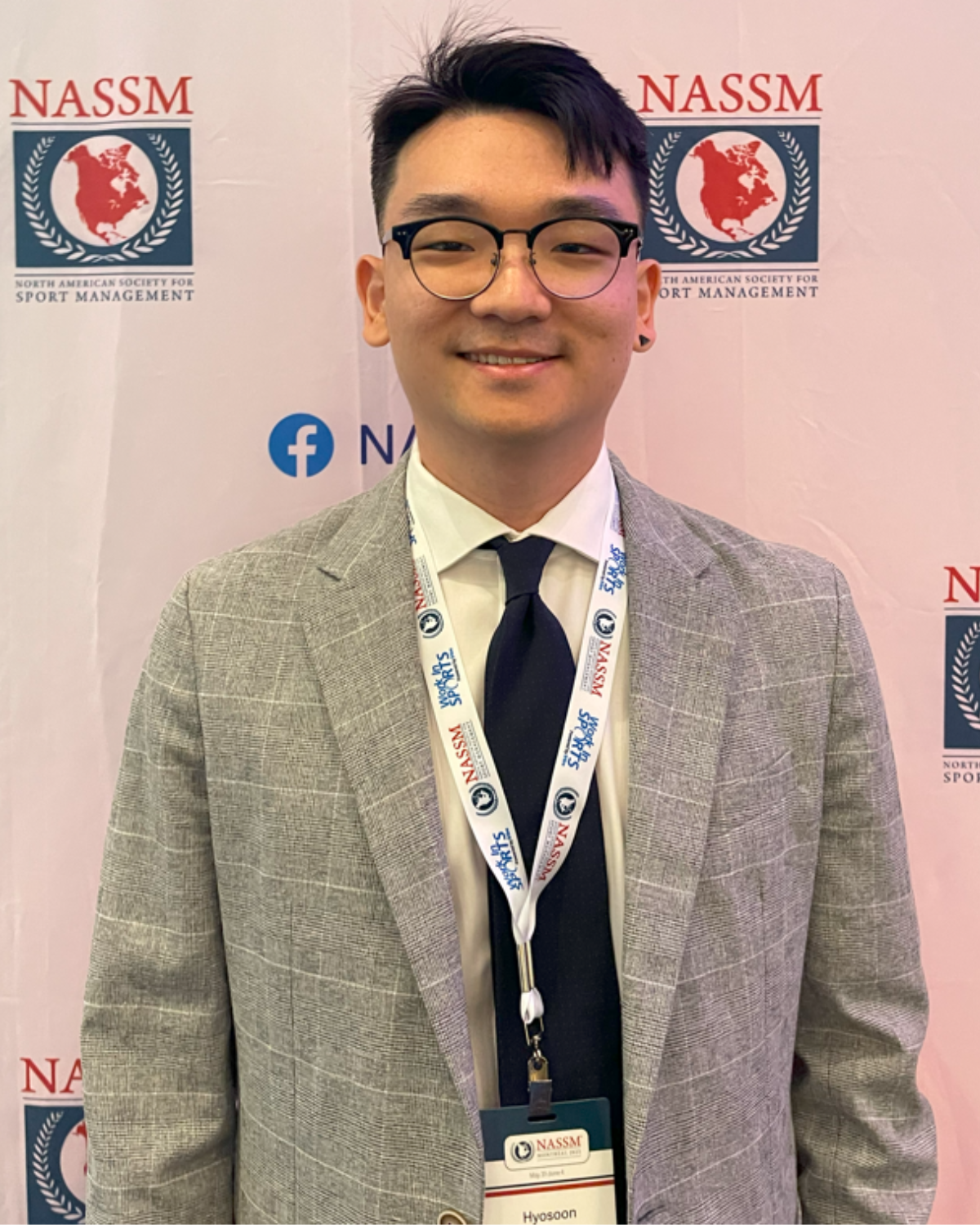
1st Place: Hyosoon Yim
Sport Management Promoting Sport Participation among Older Adults: Application of the Socioemotional Selectivity Theory

2nd Place: Tania Sultana
Biomedical Sciences ZIKV NS3 Drives Assembly of a Viroplasm-Like Structure (VLS)

3rd Place: Meng Tian
Communication The Stereotypes of Female eSports Players
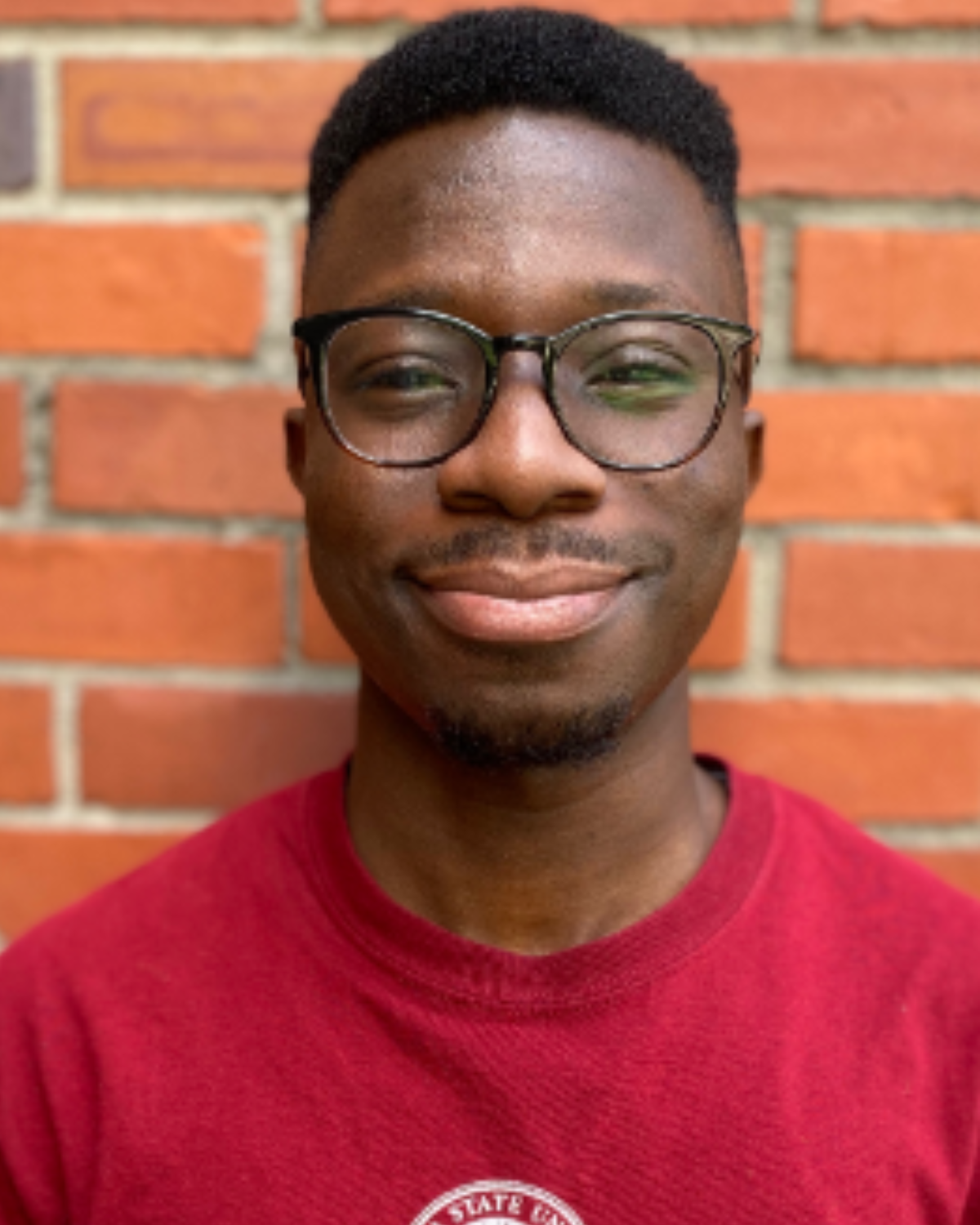
People's Choice: John Akintola
Chemistry and Biochemistry Functional Polyelectrolyte Complexes
2023 3MT Competition Finalists!

Sima Sabbagh
Neuroscience Unmasking the Architects of the Brain: Marvelous FMRP
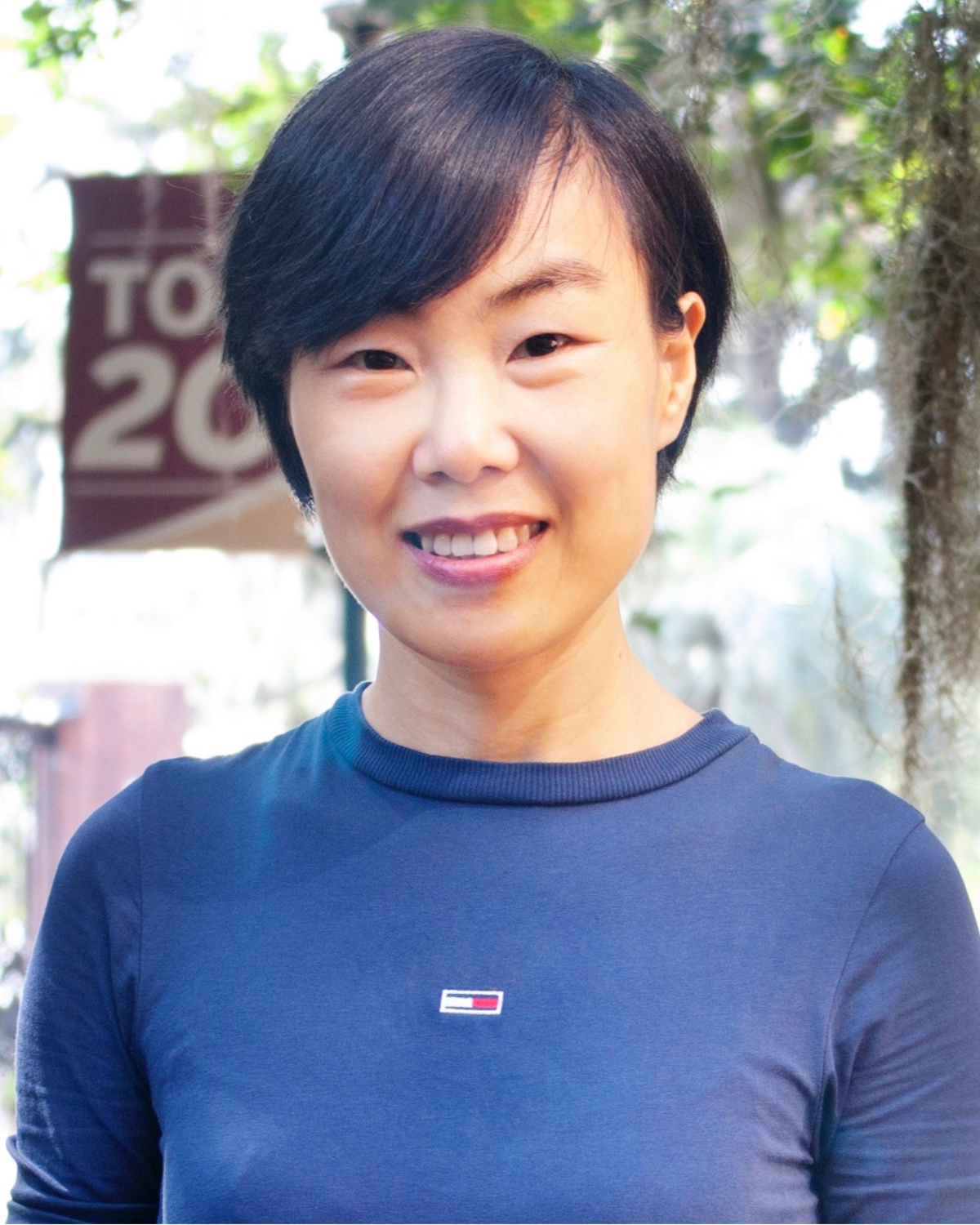
Art Education Art May Facilitate Community Building to Alleviate Chinese International Students' Alienation
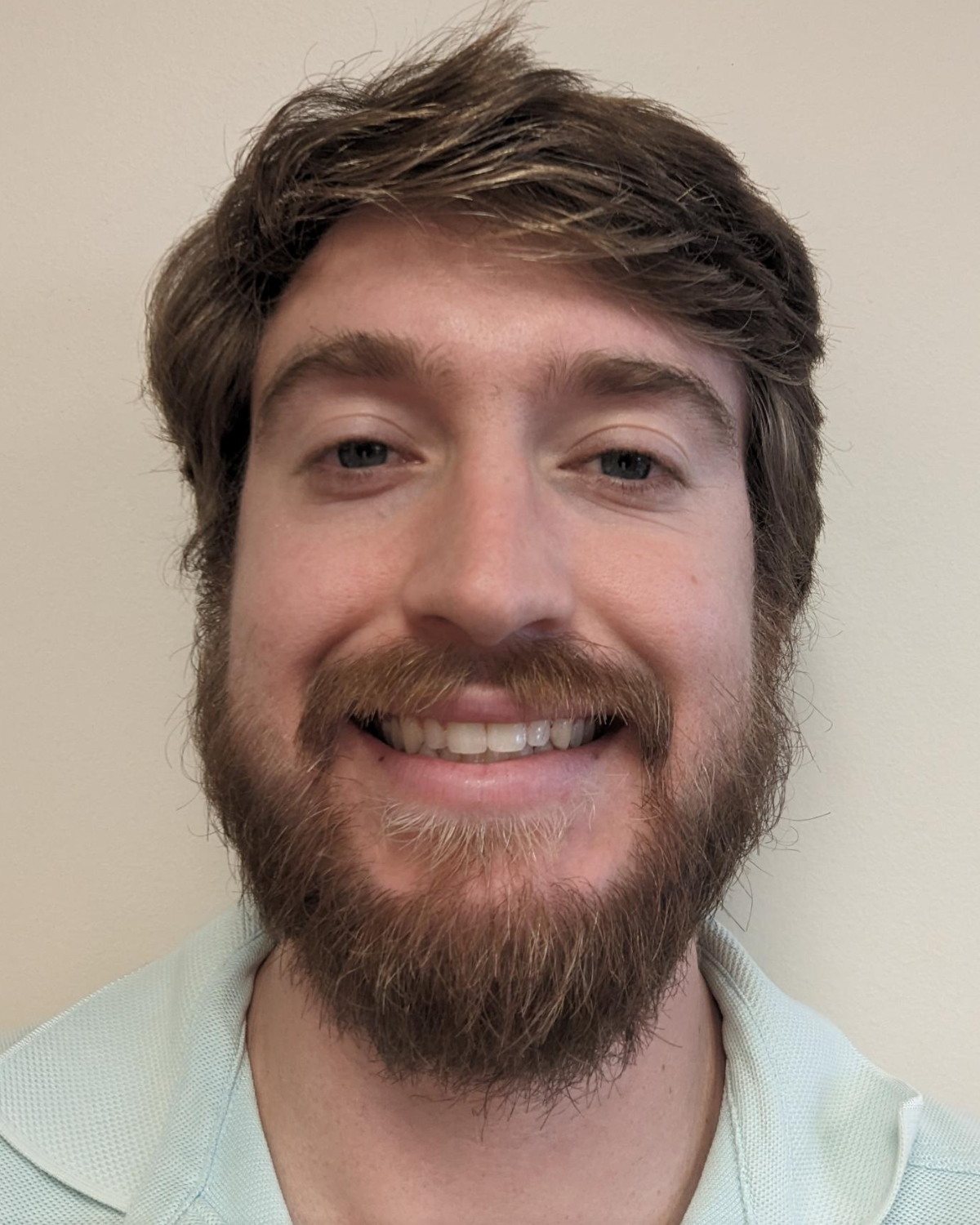
Andre Juliao
Condensed Matter Experimental Physics Nb3Sn for Axion Detection

Hemant Goswami
Molecular Biophysics Development of an Ultrasensitive and Rapid Virus Detection Method Based on CRISPR-Cas Enzyme
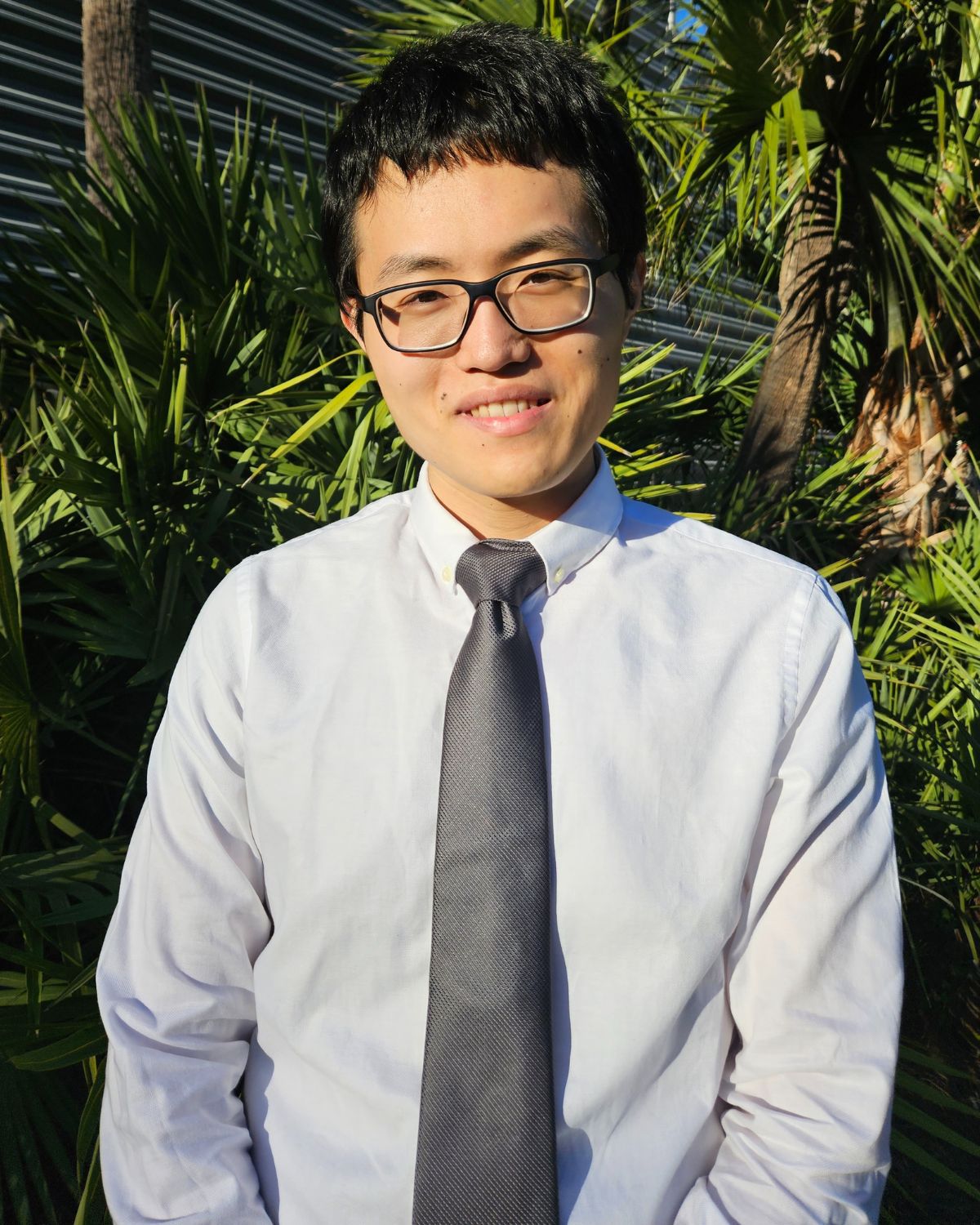
Toshiaki Kanai
Physics Quantum Computer on Solid Neon
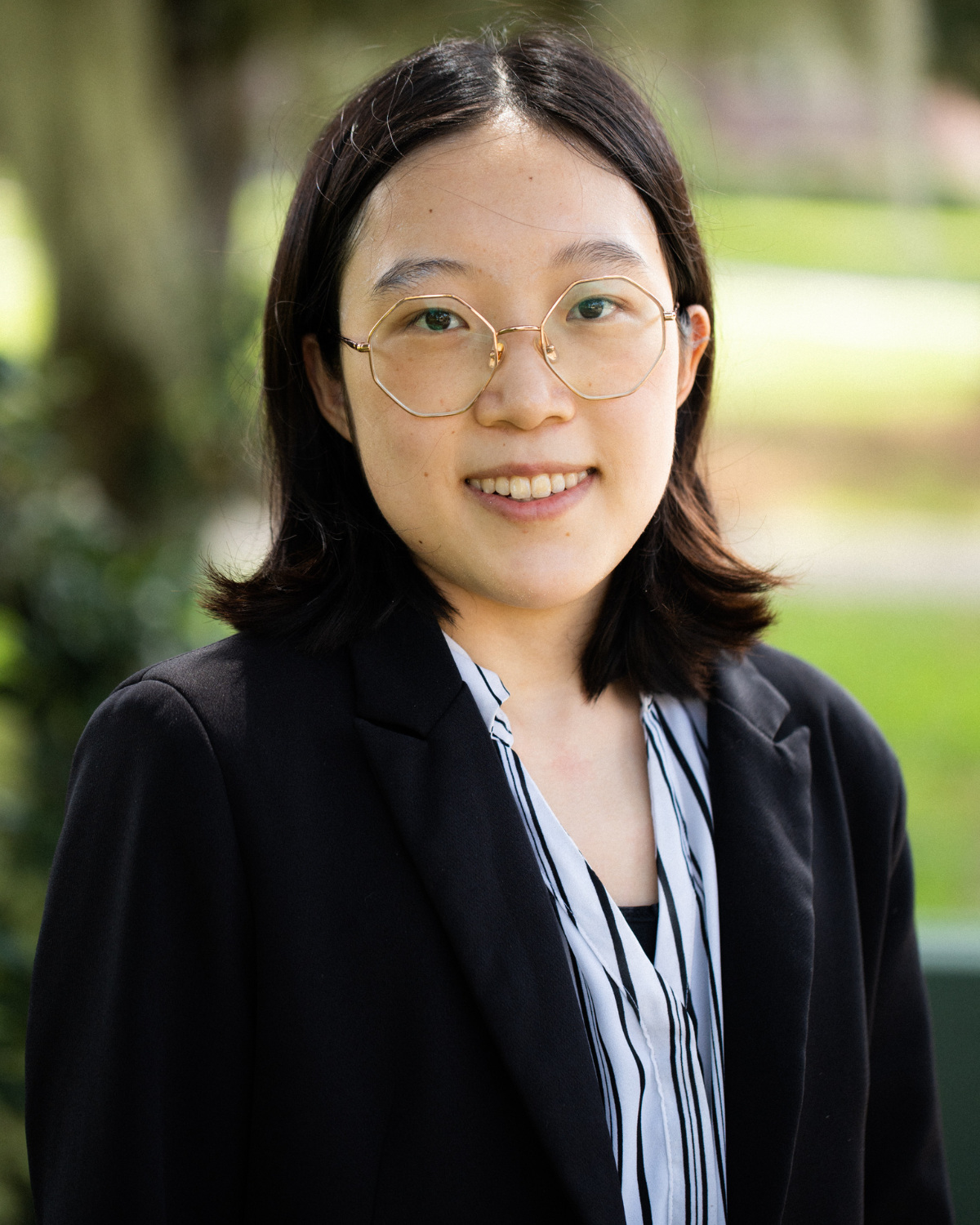
Qiushan Liu
Developmental Psychology Investigating Strategy Flexibility in Algebra
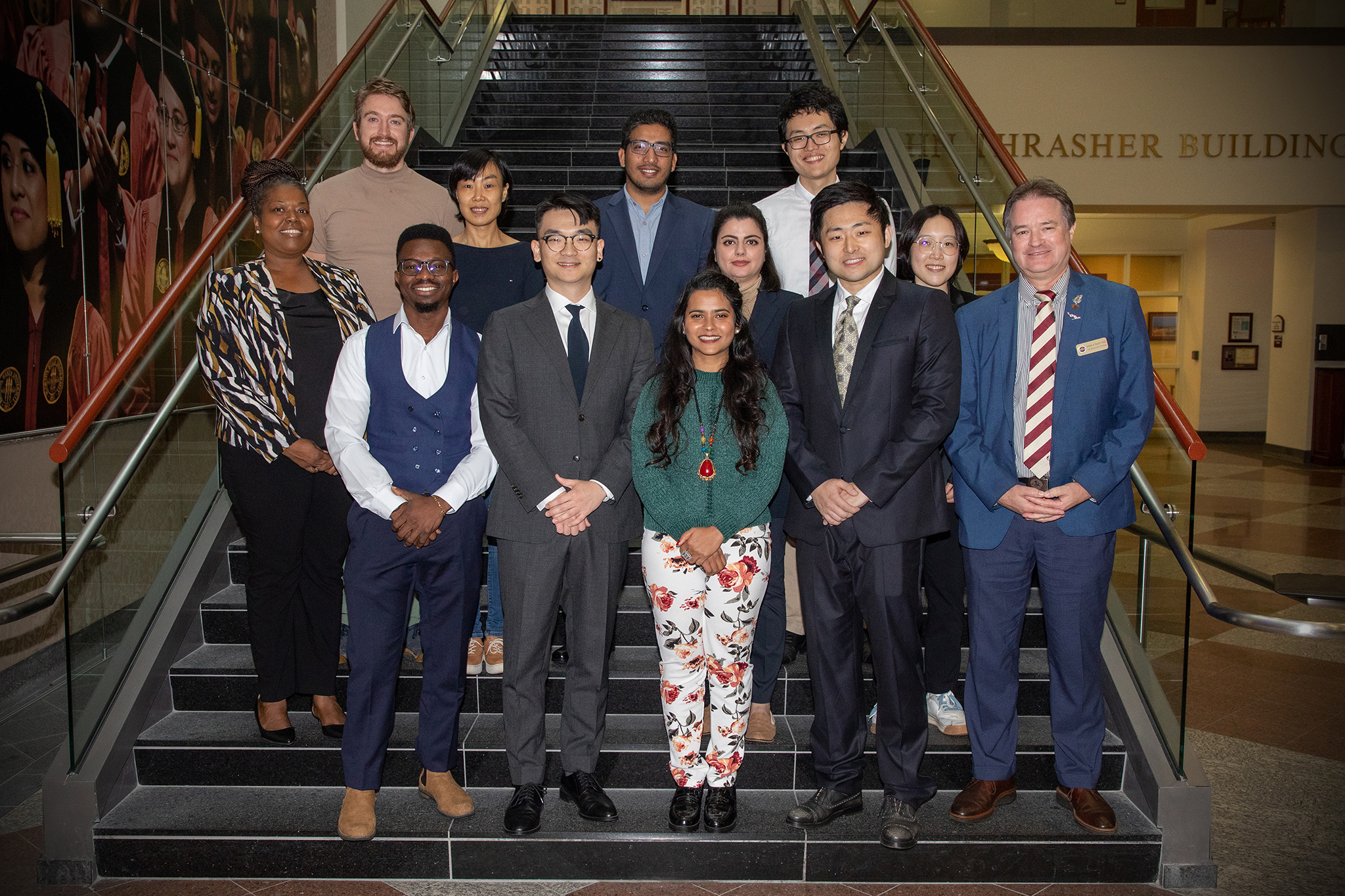
Click here to read the FSU News Article
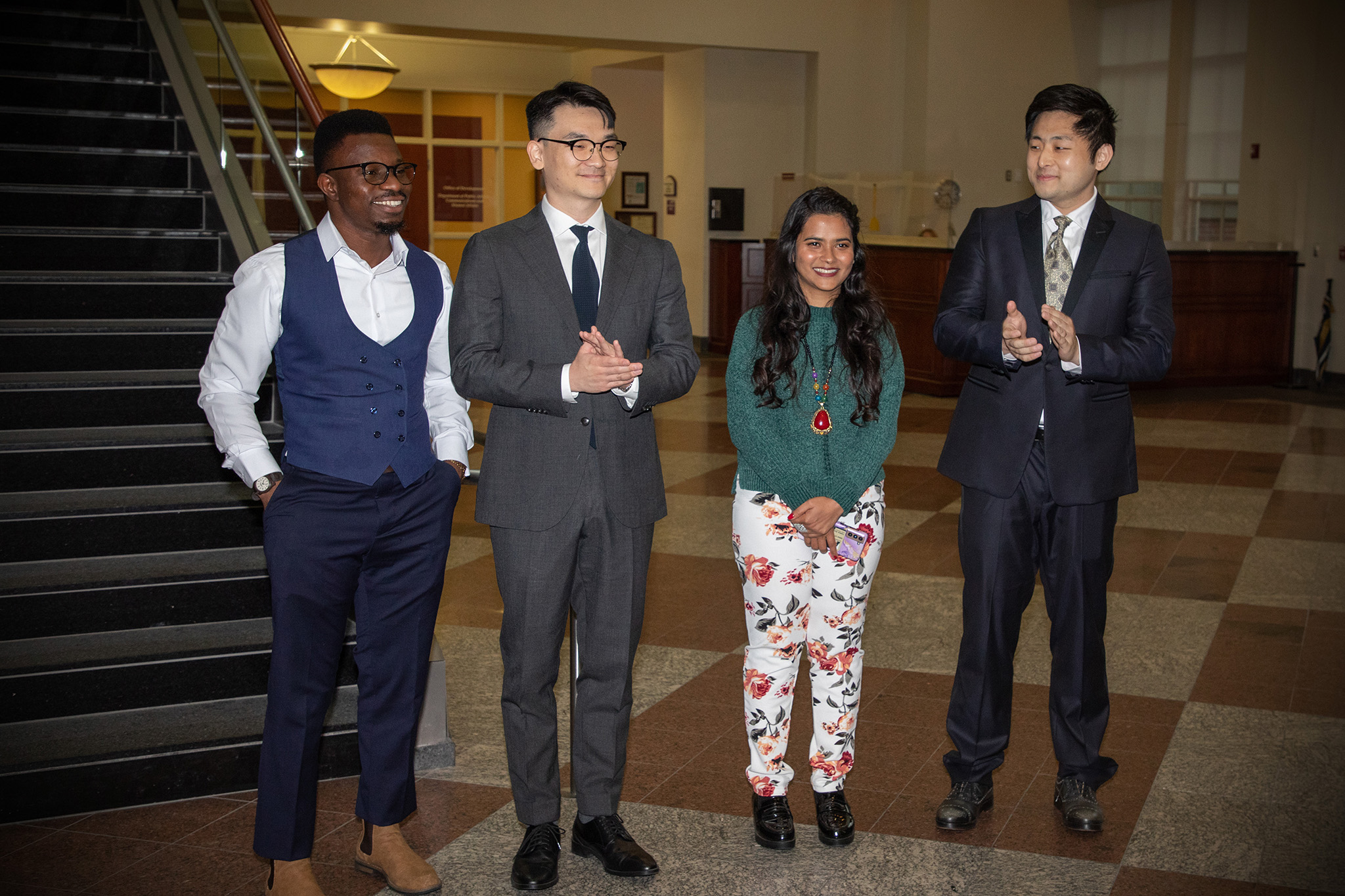
Click here to see the 2023 3MT Competition Gallery
Your graduate research. 3 minutes. 1 slide.
Why Participate?
Skills development for research candidates Participating in 3MT develops academic, presentation and research communication skills, while developing research candidates’ ability to effectively explain their research in language appropriate to a non-specialist audience.
Building external relations for the university 3MT winners go on to represent FSU at regional and national competitions which provides an excellent networking and professional development opportunity.
Are you eligible?
Currently enrolled doctoral students at Florida State University are eligible to participate in the 3MT™. 3MT® presentations must represent the primary research the student has conducted in their graduate program.
Master's students are not eligible.
What are the prizes?
- 1st Place - $1,000
- 2nd Place - $750
- 3rd Place - $500
- People's Choice (selected by the audience): $250
What are the judging criteria?
At every level of the competition each competitor will be assessed on the judging criteria listed below. Each criterion is equally weighted and has an emphasis on audience.
Comprehension and content
- Presentation provided clear background and significance to the research question
- Presentation clearly described the research strategy/design and the results/findings of the research
- Presentation clearly described the conclusions, outcomes and impact of the research
Engagement and communication
- The oration was delivered clearly, and the language was appropriate for a non-specialist audience
- The PowerPoint slide was well-defined and enhanced the presentation
- The presenter conveyed enthusiasm for their research and captured and maintained the audience’s attention
What are the rules?
- A single static PowerPoint slide is permitted (no slide transitions, animations or 'movement' of any description), and the slide is to be presented from the beginning of the oration and remain in view for the duration of the oration.
- No additional electronic media (e.g. sound and video files) are permitted.
- No additional props (e.g. costumes, musical instruments, laboratory equipment) are permitted.
- Presentations are limited to 3 minutes maximum, and competitors exceeding 3 minutes are disqualified.
- The decision of the judging panel is final.
Helpful Resources
- Click here to view the Three Minute Thesis Virtual Competition Handbook.
3MT Recording/Editing Links
- OpenShot Editing Video
- Kapwing Website
- 3MT Workshop Recording of Kapwing Editor: this video is a demonstration of the software
- Kapwing Tutorial
- FSU Canvas Support Center Tutorial : Best Practices for Student Video Production (iMovie and Movie Maker)
- Vimeo Website
Past 3MT™ Competitions
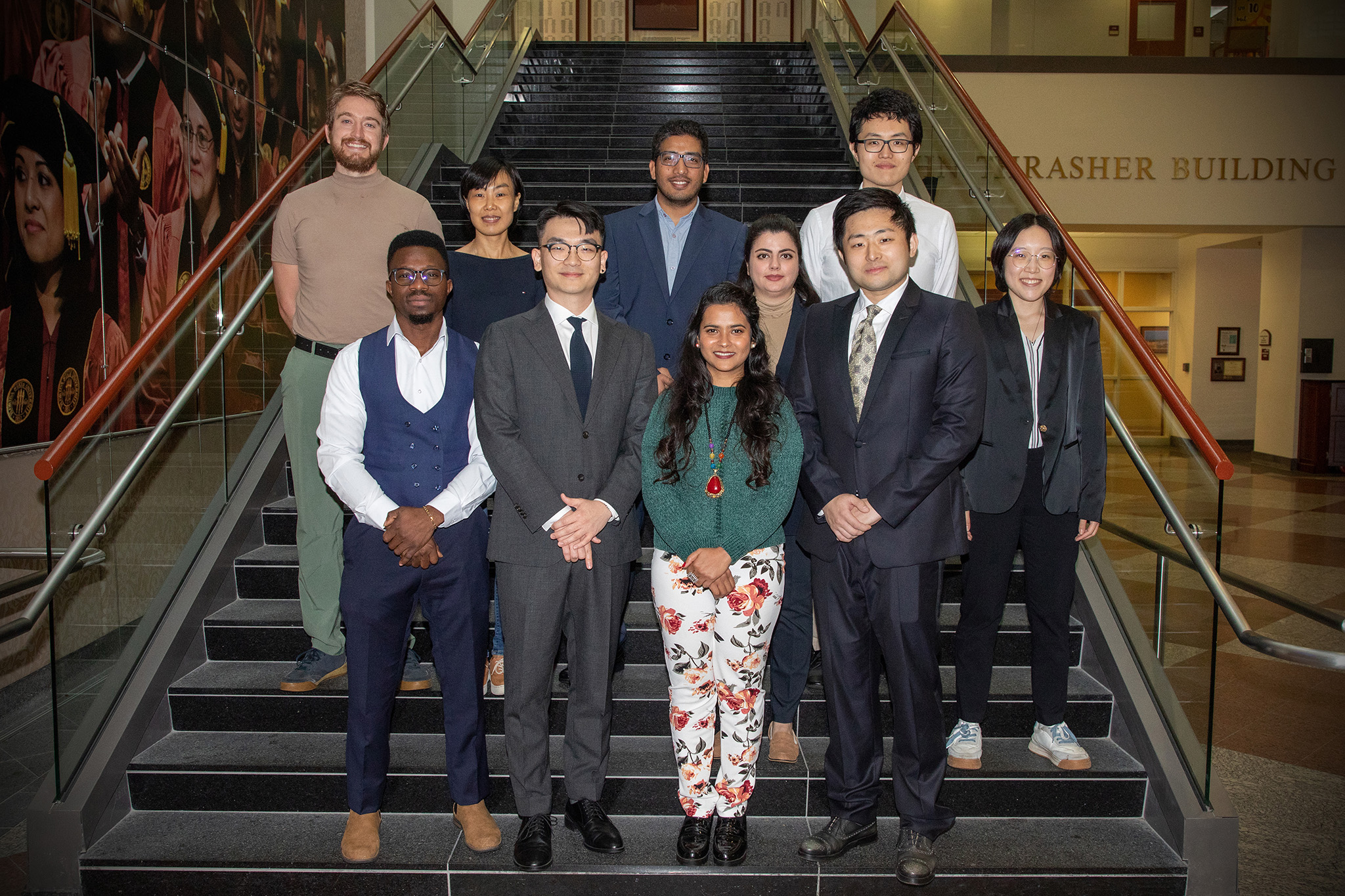
Fall 2023 3MT™
Doctoral student in Sport Management, Hyosoon Yim took first place at this year's 3MT competition and won $1,000. Read more .
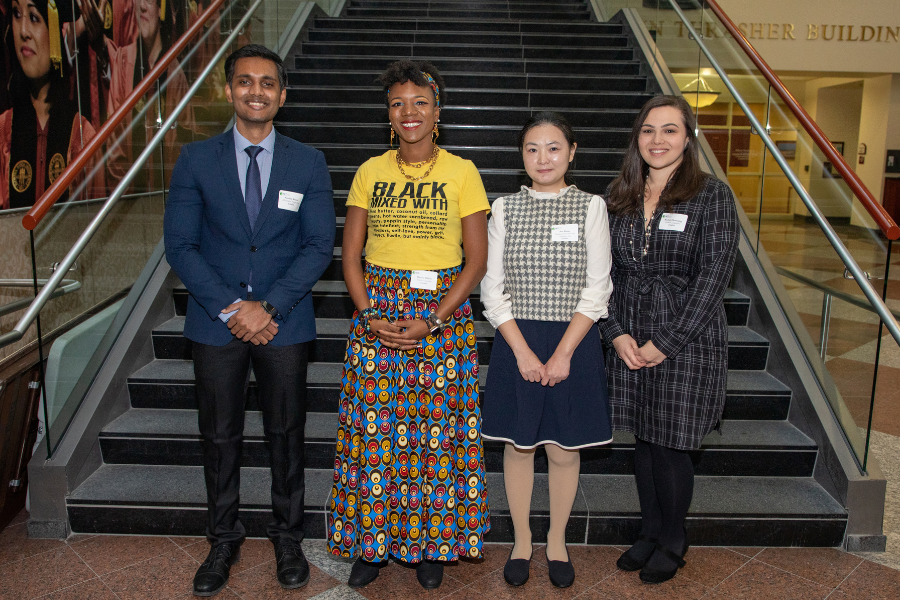
Fall 2022 3MT™
Doctoral student in Science Education, Dionne Wilson took first place at this year's 3MT competition and won $1,000. Read more .
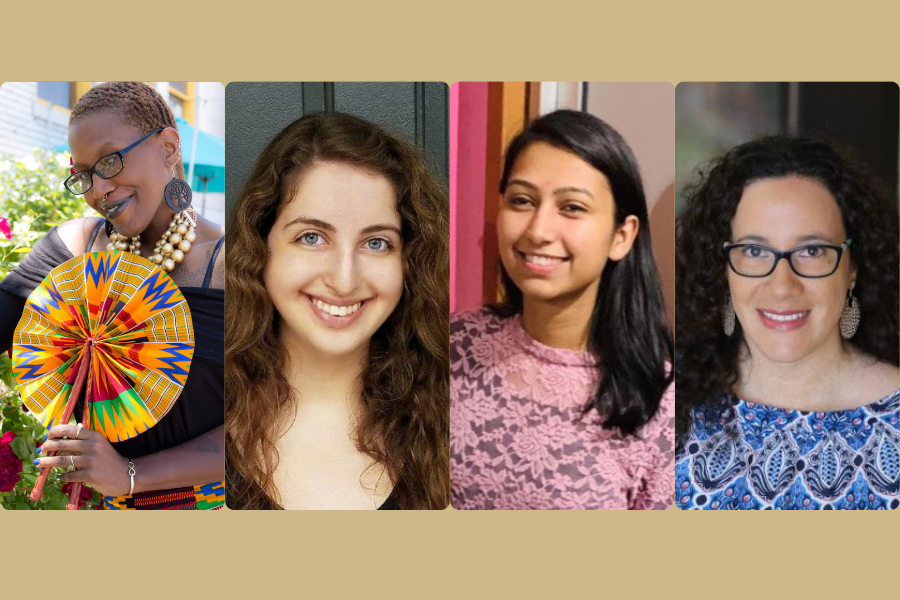
Fall 2021 3MT™
Doctoral student in Art Education, Chris Omni took first place at this year's 3MT competition and won $1,000. Read more.
Fall 2020 3MT™
Mark Duslak (Educational Leadership & Policy Studies) and Matthew Martenson (Nutrition, Food, and Exercise Sciences) finished first this year. Read more.
Fall 2019 3MT™
Judges selected Alyssa Henderson (Physics)and Sara Jones (Biomedical Sciences) as this year’s first-place winners. Read more.

Fall 2018 3MT™
Doctoral student in biological science, Eve Humphrey took first place at this year's 3MT competition and won $1,000. Read more.

Fall 2017 3MT™
For the first time, a student from the College of Education, Shannon Gooden (Teacher Education), won the $1,000 prize. Read more.
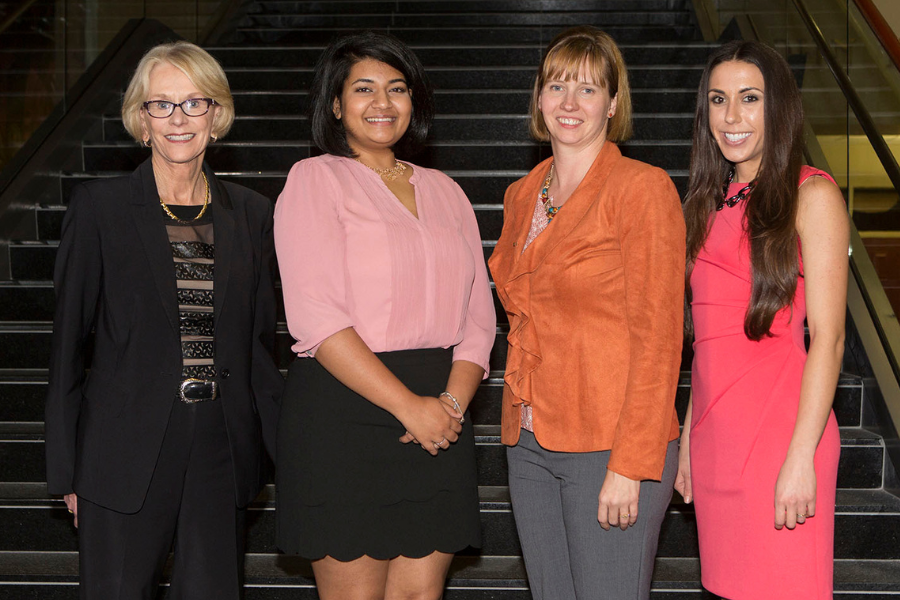
Fall 2016 3MT™
Madhuparna Roy (Industrial and Manufacturing Engineering)won first place in this year's competition. Read more.
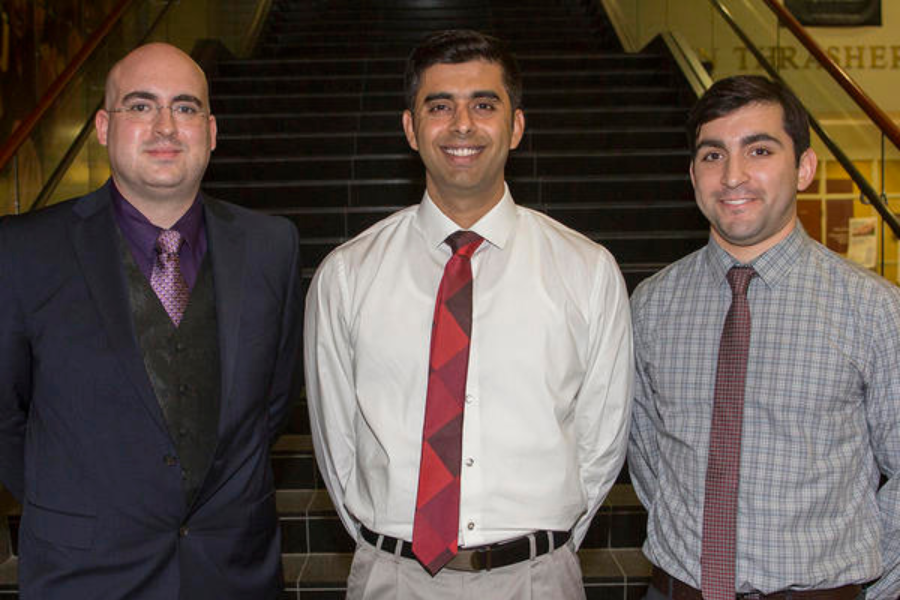
Fall 2015 3MT™
Aniket Ingrole (Industrial and Manufacturing Engineering) won first place in the 3MT™ competition. Read more.
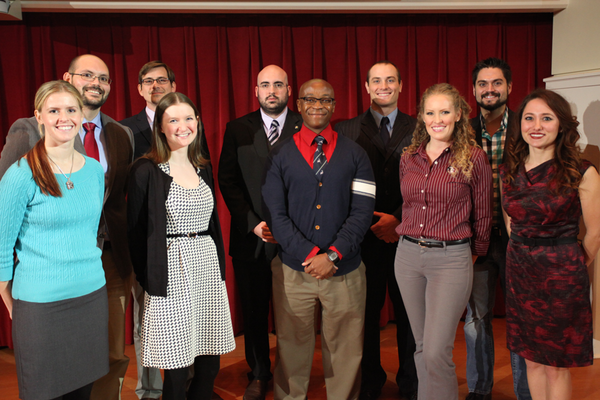
Fall 2014 3MT™
Kimberly Smith (Neuroscience) won first place in this year's 3MT™ competition. Read more.
View the past 3MT competition galleries
Designing a Winning 3MT Slide
By now, many of you will have entered this year’s 3 Minute Thesis competition. For the last few years, I’ve had the privilege of being AUT’s 3MT scorekeeper. I tally up the judges’ marks and facilitate their deliberations. Every year, I have an inside view of the judges’ room, and boy, it’s given me some insights.
Chief among those insights is the importance of the 3MT slide. Entrants only get one slide to display during their 3-minute presentation. There can be no sound effects, no animations, no audio or video of any kind. Just that one slide. Static. Still. Hanging there in the background.
As an entrant – and I know this from having been one myself – it’s easy to overlook the slide and focus on the content of the 3-minute talk. But that’s a huge mistake.
The design of the slide fundamentally influences the judges’ impressions of the whole presentation. There are no points allocated for it specifically, but it sets the lasting mental image that judges will retain of your presentation. They won’t remember every word you said, but they will remember your slide; and they’ll have it in mind as they award points and choose a winner.
The slides that tend to earn positive comments from judges are:
- Uncluttered. Think simple, clean design.
- Pictorial. Text-heavy slides are generally frowned upon; whereas images and simple graphics tend to be well-received.
- Often metaphorical or conceptual. Many successful slides use one impactful image that represents the main point of the presentation.
- Memorable. A punchy slide keeps you in the judges’ minds.
- Academically relevant. You don’t need to include lots of complicated graphs or stats to demonstrate your research credibility, but you do need to ensure that your slide relates to your research.
The good folks at 3 Minute Thesis headquarters have provided the below examples of ‘bad’ and ‘good’ slide design on their Facebook page . Of course, these things are subjective, and all judges will have slightly different opinions of what makes a good slide. However, these will give you an idea of best practice.
Another key reason to favour simple slide design is that it influences your delivery. At the 3MT, points are weighted equally for the presentation’s ‘Comprehension and Content’ (research content) and ‘Engagement and Communication’ (delivery). That means that 50% of your score comes from how well you communicate with the audience. The ‘busy’ sample slide above would encourage the presenter to turn toward the slide and away from the audience, which is a dangerous way to lose them. The simple slide design, on the other hand, makes a great backdrop; allowing the audience to connect primarily with the presenter.
3MT is very much about that connection; about communicating the ‘big picture’ of your research in a way that makes it understandable to people from outside your discipline. That’s why it’s so important that your visual supports your key idea in a clear, uncomplicated way. Too much detail can leave the judges squinting in confusion. Design your slide to leave them wide-eyed in wonderment instead.
A quick note: you don’t need to include your name or any affiliation details on your slide. During 3MT events at AUT, we display your name, programme, faculty, supervisors’ names, and presentation title on a separate slide as the MC introduces you. That’s one less thing to worry about!
About Anaise Irvine
Leave a reply cancel reply.
Your email address will not be published. Required fields are marked *
Save my name, email, and website in this browser for the next time I comment.

- Thompson Rivers University Library
- Research Guides
3 Minute Thesis (3MT)
Graphic design principles, public speaking & feeling confident, 3mt resources, scholarly communications librarian.

TRU 3MT Competition
- TRU 3MT Competition Website Register and submit your presentation slide by March 15, 2024.
The 3 Minute Thesis (3MT)

- 3 Minute Thesis - University of Queensland Click "Resources" for competitor rules and guidelines
- 3 Minute Thesis Slide Template Download this PowerPoint template and follow the instructions to prepare the slide for your presentation.
Undergraduate student or faculty member, but want to participate? Check out TRU's other 180 second research competitions during Research Month . The information and rules on this page specifically refer to the graduate 3MT, but will help you no matter which competition you are in: https://www.tru.ca/research/research-month.html
3 Minutes Thesis Slide
Your slide plays an important role in how you present and deliver the content of your thesis.
Think of the 3 minute slide as a backdrop to a play. The slide serves as your "theatrical set" to your "one man show". The slide sets the tone and graphically conveys the information to which you are speaking to.
- a single, static, slide is permitted
- no slide transitions, sounds, animations or 'movement' of any description are permitted
3MT winning presentations
- More winning presentations
Design matters
The more strikingly visual your presentation is, the more people will remember it. And more importantly, they will remember you. — Paul Arden
Good graphic design is not about decoration or making something look super fancy. Design is about making communication as easy and clear as possible.
Rule of Thirds
The rule of thirds is a principle of the Golden ratio with broad application as a "rule of thumb" or guideline which applies to the process of composing visual images such as designs, films, paintings, and photographs. The guideline proposes according to the principle of the Golden section search that an image should be imagined as divided into nine equal parts by two equally spaced horizontal lines and two equally spaced vertical lines, and that important compositional elements should be placed along these lines or their intersections. Proponents of the technique claim that aligning a subject with these points creates more tension, energy and interest in the composition than simply centering the subject. - Wikipedia
White Space
- You need white space to help balance the images and text on your slide.
- Empty space is not negative or bad space. White space creates harmony and balance.
Using colour is an important aspect of delivering your message. Colour can help convey emotion, but keep in mind that colour association is culturally specific. For example, the colour white can mean purity in some cultures, but in other cultures white is associated with mourning.
It is a good rule of thumb to use colour sparingly (2-3 colours maximum).
Things to think about:
Contrast - shoot for high contrasting colours. Avoid black text on an all white background as that can cause glare and eye strain.

Serif vs San Serif Font
Resist the temptation to put your entire thesis on your slide. Your slide should convey the essence of your thesis and is meant to complement your spoken presentation.
Only include things that are:
- critical, essential and relevant
- metaphors or analogies to catch your audience's attention
- excellent graphical representations of a concept

image source: http://drmarkwomack.com/images/serif-vs-sans-serif.png
Tools for Finding Images
Remember: even if an image is in the public domain, you should still cite it! For the 3MT slide, the citation text can be small and out of the way.
TRU Library image databases - permitted to use images for educational purposes
Public Domain Images
Public domain: the copyright on public domain photos (and other works) has either expired or otherwise doesn't exist. You may use public domain work without worrying about getting permission, but you should still cite them, because they are not your work!
- Getty Open Content Program You can find these images by conducting a search on the Getty Search Gateway and then filtering your results by checking the box next to "Open Content Images", which is the second option in the Highlights section of the filters in the left menu. All images found through this program should be credited as "Digital image courtesy of the Getty's Open Content Program"
- Google Images Use Advanced Search / Usage Rights / "Creative Commons licenses"
- The Metropolitan Museum of Art Images that are in the public domain will be marked as such.
- NASA Image Library NASA still images, audio files, video, and computer files used in the rendition of 3-dimensional models, such as texture maps and polygon data in any format, generally are not copyrighted.
- Pixabay See FAQ under Help for information regarding re-use of images.
- Public Domain Review a collection of images, books, films and audio files that are available in the public domain. The collection can be browsed by medium, time period, tag and source.
- Rijksmuseum Images on the Rijksmuseum website are fully searchable and downloadable. Each item that has entered the public domain includes this information in the section of the item description entitled acquisition and rights.
- U.S. Department of Agriculture Image Gallery Because the images were mostly taken for the government, virtually all are in the public domain. Any images that are not in the public domain are marked as such.
- Wikimedia Commons Freely usable media files (images, audio, video). Check the image summary for details on permitted use.
- Yale University Art Gallery You can find more information on properly attributing images on the Art Gallery's Terms of Use page.
Creative Commons Images
For more info on creative commons, click here .
- Creative Commons Search Search a variety of media.
- Compfight Refer to "Learn about Photo Licenses" for information about re-use of images.
- PhotoPin This image search engine returns both Creative Commons and non-Creative Commons images. When you download any image, you can also download the necessary HTML to appropriately attribute the image to its creator.
- Bucketlistly Devoted to CC BY-NC licensed travel photos.
- Europeana, 1914-1918 Europeana is an online collection of content from European libraries, archives, museums and other institutions. Once you run a search in their search bar, you can limit your results to items that are freely usable or available under a Creative Commons license using the facets under Copyright in the left menu.
- The Stocks This website collects sites that offer access to high-resolution images available for use under Creative Commons licenses. Most of the sites offer the images under CC0 licenses and all of the sites clearly state how their images are licensed.
- Multicolr Search Lab allows you to search for Creative Commons-licensed images by color
Vector & Raster Graphics
Vector based images (.ai, .eps, .svg, and some .pdf) are based on a mathematical equation. For example, if your image is a circle in vector format, that circle is simply a mathematical formula. If you resize that circle by 1000x, the mathematical formula would still calculate that circle in proportion. This means that no matter how you resize vector images they will scale properly and there will never be any pixelation.
Raster based graphics, (.bmp, .jpg, .png, .gif, .tif, etc.) are based on a grid of pixels or dots. The pixels represent certain colors that make up a bigger image and are resolution dependent. When you resized a raster graphic, they eventually start to pixelate due to the pixels being “stretched” beyond their original size.

3MT In 3 Minutes
How to look confident when you aren't feeling confident
Remember: your audience wants you to succeed. No one is plotting for your failure.
Check out your classroom in advance
Familiarize yourself with the layout of the of the room. Where is the spot where you will be speaking from? Is there a podium? How are the desks or chairs arranged? Will you need audio-visual equipment (ie. laptop or a mac computer connector)? How do the lights turn on/off? Is there a chalk board or dry wipe board?
Practice your lecture beforehand
If possible, practice giving your lecture/speech in the room where you will be doing it. Practice your timing and record the amount of time for each portion of your lecture/speech on your speaker's notes to help you keep track of the pacing of your lecture/speech when you are doing it for real.
PRO TIP: See your lecture as your audience will see it and have a friend record your presentation practice. Use that recording to look for ways to streamline your presentation or find out if you have any verbal or non-verbal habits that can be corrected or minimized.
Bring water
Not only will the water quench a sudden dry throat, but it can also act as a prop. While you won't have time in your 3 minute thesis to sip water, having it before and after helps.
Wear clothing that is professional and exudes confidence. Your clothes should be comfortable and loose enough so that you can move around. Check for potential wardrobe malfunctions.
Script vs Notes
As you work on your presentation, you may start with a detailed script. It is a good idea to distil that script into an outline.
It is best to have your 3MT presentation memorized, but if you have to rely on notes they should be detailed enough to include key definitions, examples, analogies and any other detail that you think you might need some support if you get nervous in front of the room.
Talisman or special token
If you have a small token, good luck charm or special piece of jewelry that makes you feel good, have it on you.
If you have a song or playlist that gets you going and makes you feel good, listen to it on your way to the competition to get PUMPED UP!
Kathy's secret song....
What you are aiming for is.....
- Authoritative
To achieve that:
- Maintain regular eye contact
- Speak clearly and enunciate: Make sure that not only do you keep regular eye contact, but try to have your audience see your face and mouth as much as possible. It helps many understand what you are saying and understand meaning.
- Use your body and use the space
- Vary speed and pitch; facial expressions: Don’t yell … you are having a conversation with your audience.
- Use an analogy or story to make your research relatable, but avoid these three conversation stoppers: sex , religion and politics
- Because you aren't reading a script, you'll be able to watch your audience's reaction to your delivery. Are they confused? Do they understand what you are saying? Look for body language and adjust accordingly.
- Include delivery reminders. Leave yourself notes and reminders within your notes. For example, "Breathe".. or "Slow Down" or sample questions to spur conversation or classroom contribution.
These resources provide tips and tricks for preparing your slide, sharing your research, and preparing to present at the 3MT competition.
- 11 Tips for the 3 Minute Thesis Competition Henry Miller (UT Health San Antonio)
- How to Talk about Your Thesis in 3 Minutes Inger Mewburn (RMIT University)
- Your Time Starts Now: A Guide to...the 3MT Competition Simon Clews, University of Mebourne
- How Grad Students can Effectively Tell their Research Story Jackie Amsden (Simon Fraser University)
- Tips and Techniques for More Confident and Compelling Presentations Matt Abrahams (Stanford University)
- Think Fast, Talk Smart: The Podcast Matt Abrahams (Stanford University)
- Six Pieces of Bad Speaking Advice that Just Won't Die Anett Grant (Executive Speaking)
- Last Updated: Feb 27, 2024 12:05 PM
- URL: https://libguides.tru.ca/3mtslides

- Schools & departments

About 3 Minute Thesis
Information about the competition and details of who to contact.

Three Minute Thesis (3MT®) is an academic competition developed by The University of Queensland (UQ), Australia.
About the competition
The 3 Minute Thesis (3MT) competition requires doctoral researchers to compete to deliver the best research presentation in just 3 minutes (and one slide). It is based on a concept developed by the University of Queensland which quickly spread across Australia and New Zealand, and has gone global.
The University of Edinburgh has run a 3MT competition every year since 2013.
- A single static PowerPoint slide is permitted. No slide transitions, animations or 'movement' of any description are allowed. The slide is to be presented from the beginning of the oration.
- No additional electronic media (e.g. sound and video files) are permitted.
- No additional props (e.g. costumes, musical instruments, laboratory equipment) are permitted.
- Presentations are limited to 3 minutes maximum and competitors exceeding 3 minutes are disqualified.
- Presentations are to be spoken word (e.g. no poems, raps or songs).
- Presentations are to commence from the stage.
- Presentations are considered to have commenced when a presenter starts their presentation through either movement or speech.
- The decision of the adjudicating panel is final.
Eligibility
Active PhD and Professional Doctorate (Research) candidates who have successfully passed their confirmation milestone (including candidates whose thesis is under submission) by the date of their first presentation are eligible to participate in 3MT competitions at all levels. Graduates are not eligible.
Judging Criteria
Comprehension and content
- Did the presentation provide an understanding of the background and significance to the research question being addressed, while explaining terminology and avoiding jargon?
- Did the presentation clearly describe the impact and/or results of the research, including conclusions and outcomes?
- Did the presentation follow a clear and logical sequence?
- Was the thesis topic, research significance, results/impact and outcomes communicated in language appropriate to a non-specialist audience?
- Did the presenter spend adequate time on each element of their presentation - or did they elaborate for too long on one aspect or was the presentation rushed?
Engagement and communication
- Did the oration make the audience want to know more?
- Was the presenter careful not to trivialise or generalise their research?
- Did the presenter convey enthusiasm for their research?
- Did the presenter capture and maintain their audience's attention?
- Did the speaker have sufficient stage presence, eye contact and vocal range; maintain a steady pace, and have a confident stance?
- Did the PowerPoint slide enhance the presentation - was it clear, legible, and concise?
More information about 3 Minute Thesis
Find detailed information about the 3 Minute Thesis Competition, including tips on how to prepare, in our new handbook for participants:
3 Minute Thesis participant handbook (PDF)
You may also find our web information helpful:
- How to enter and competition criteria
- Frequently asked questions
College Prizes
At each College heat, three winners will be selected to go through to the University final; further prizes to be confirmed.
University Prizes
All those who take part at the University competition will have their presentations filmed and uploaded to the University YouTube channel. Our thanks go to the Principal for the generous donation of funds for this year’s prizes for the winners of the 3 Minute Thesis Finals. We are very grateful for this support, and are happy to announce this year’s prizes:
1st Prize : £1000
Runner up: £400
Peoples’ Choice Award : £400
The winner of the University of Edinburgh competition is then entered into the UK Competition and the international Universitas 21 Competition.
Details of the final prizes are still to be confirmed by Universitas 21.
Feedback from previous winners
Read our guest blog posts from Owen Gwydion James 2018 winner of the UK competition, Chen Zhao, 2015 Competition Winner, Emma Hodcroft, 2014 Competition Winner, and Mara Götz, 2013 ‘People’s Choice’ Winner on their experience of the competition:
Read Owen Gwydion James's guest blog post
Read Emma Hodcroft's guest blog post
Read Mara Götz's blog post on participating in 3MT
Read Chen Zhao's blog post
Contact information
Please contact Louise if you have any questions:
Louise McKay
Events Operations and Doctoral Programme Manager

Contact details
- Work: 0131 651 7189
- Email: [email protected]
This article was published on 2024-02-26
3MT competitor guide
Even the world’s best public speakers prepare before important presentations. To assist you with your preparations, please find a few suggestions below that will help you in writing your presentation, creating your slide and practising your presentation.
- 3MT drafting
- 3MT presentation
- Examples of 3MT presentations
Write for your audience
- Avoid jargon and academic language.
- Explain concepts and people important to your research - you may know all about Professor Smith’s theories but your audience may not.
- Highlight the outcomes of your research, and the desired outcome.
- Imagine that you are explaining your research to a close friend or fellow student from another field.
- Convey your excitement and enthusiasm for your subject.
Tell a story
- You may like to present your 3MT as a narrative, with a beginning, middle and end.
- It’s not easy to condense your research into three minutes, so you may find it easier to break your presentation down into smaller sections.
- Try writing an opener to catch the attention of the audience, then highlight your different points, and finally have a summary to restate the importance of your work.
Have a clear outcome in mind
- Know what you want your audience to take away from your presentation.
- Try to leave the audience with an understanding of what you’re doing, why it is important, and what you hope to achieve.
- Proof your 3MT presentation by reading it aloud, to yourself and to an audience of friends and family.
- Ask for feedback.
- Ask your audience if your presentation clearly highlights what your research is about and why it is important.
Before you start work on your slide, you should take the following rules into account:
- One single static PowerPoint slide is permitted;
- No slide transitions, animations or ‘movement’ of any description are permitted;
- Your slide is to be presented from the beginning of your oration; and
- No additional electronic media (e.g. sound and video files) are permitted.
Suggestions
You may like to consider some of the following suggestions.
- Less is more: text and complicated graphics can distract your audience – you don’t want them to read your slide instead of listening to your 3MT.
- Personal touches: personal touches can allow your audience to understand the impact of your research.
- Creativity drives interest: do not rely on your slide to convey your message – it should simply complement your oration.
- Work your message: think about how your slide might be able to assist with the format and delivery of your presentation – is there a metaphor that helps explain your research?
- An engaging visual presentation can make or break any oration, so make sure your slide is legible, clear and concise .
Practice, practice, practice
- Feeling nervous before you present is natural, and a little nervousness can even be beneficial to your overall speech. Nonetheless, it is important to practice so you can present with confidence and clarity. Practicing will also help you gauge the timing of your 3MT so that you keep within the time limit.
Vocal range
- Speak clearly and use variety in your voice (fast/slow, loud/ soft).
- Do not rush – find your rhythm.
- Remember to pause at key points as it gives the audience time to think about what you are saying.
Body language
- Stand straight and confidently.
- Hold your head up and make eye contact.
- Never turn your back to the audience.
- Practise how you will use your hands and move around the stage. It is okay to move around energetically if that is your personality, however it is also appropriate for a 3MT presentation to be delivered from a single spot on stage.
- Do not make the common mistakes of rolling back and forth on your heels, pacing for no reason or playing with your hair as these habits are distracting for the audience.
Record yourself
- Record and listen to your presentation to hear where you pause, speak too quickly or get it just right.
- Then work on your weaknesses and exploit your strengths.
Look to the stars!
- Watch your role models such as academics, politicians and journalists, and break down their strengths and weaknesses.
- Analyse how they engage with their audience.
- View presentations by previous 3MT finalists .
- There is no dress code, if you are unsure of how to dress you may like to dress for a job interview or an important meeting. It is important that you feel comfortable so you can focus on your presentation.
- If you are presenting on a stage that has a wooden floor, be aware of the noise your footwear might make.
- Do not wear a costume of any kind as this is against the rules (as is the use of props).
For ideas and inspiration on how to develop your own 3MT presentation, there are many examples of previous 3MT finalists from a broad range of disciplines on our website:
- Past UQ Competition Finalists
- Past Asia-Pacific Competition Finalists
- Past Finalists from around the world

IMAGES
VIDEO
COMMENTS
Tip #3: Choose an eye-catching visual… or make one 👀. In the same way that 'the hook' in your 3MT script helps to pique the audience's attention, the slide is another important tool to capture their attention and keep them engaged. But to do this, it needs to be eye-catching and interesting.
Learn about how to design a single slide for UW-Madison Graduate School's 3-Minute Thesis Competition with these five easy guidelines.More Details about the ...
Tips for effective design and use of the 3-minute thesis slide The audience will have a full 3 minutes to absorb your slide. It needs to actively contribute to your talk, rather than simply provide a backdrop. 1. Keep it simple The slide should support you as you talk, but should not take over. It will be
The Three Minute Thesis (3MT®) is an international competition celebrating the exciting research conducted by PhD students. Developed by the University of Queensland in 2008, the competition requires contestants to condense their research into a three-minute, one-slide presentation for a non-specialist audience.
The Three Minute Thesis (3MT®) Competition is an annual public speaking competition, where PhD candidates describe the impact and scope of their research in 3 minutes to a non-specialist audience. It was launched by the University of Queensland in 2008 and has since gained traction in over 85 countries around the world! 🌍
Three Minute Thesis (3MT®) is an academic research communication competition developed by The University of Queensland (UQ), Australia. While the original competition was for graduate students, a number of colleges are now sponsoring undergraduate competitions. 3MT offers seniors the opportunity to create an accessible and interesting ...
How to win the 3 minute thesis - By Dr Inger Mewburn (aka @thesiswhisperer) Making the most of your 3 minutes - Simon Clews, University of Melbourne. Talk nerdy to me - Melissa Marshall's TED talk. Vitae's 3MT webpages . These guidance pages are part of the University of Queensland's official 3MT competitor resources.
The three-minute thesis (3MT) is a new format of research presentation that builds on the classic "elevator pitch". The challenge in this type of presentation is to explain your research to an intelligent non-specialist audience in under 3 minutes with limited visual aids.
The Basics. 180 seconds/ 3 minutes/ ~450 words. 1 static powerpoint slide. No props or other media. No transitions or animations. No singing, rapping, etc. Present your research to a non-specialist audience. A panel of multidisciplinary judges. Faculty in other disciplines.
3MT®: The three minute thesis FROM THE UNIVERSITY OF QUEENSLAND WEBSITE: Three Minute Thesis (3MT®) is a research communication competition developed by The University of Queensland which challenges research higher degree students to present a compelling oration on their thesis and its significance in just three minutes in language appropriate to a non-
Three Minute Thesis (3MT®) is a competition for doctoral and research students to develop and showcase their research communication skills through brief, 3-minute presentations. ... they cannot ask someone else to design the slides. Use of PowerPoint templates is allowed. Slides can include visual elements (charts, visualizations, photos, clip ...
The 3MT time limit ... 3 minutes. The 3-Minute Thesis (3MT®) is a research communication competition that challenges students to communicate the significance of their projects without the use of props or industry jargon, in just three minutes. Originally established by the University of Queensland (UQ) in 2008, the competition challenges ...
What is the Three Minute Thesis competition? The 3MT is an academic competition that helps graduate students clarify and explain their research to others in a fun and collegial way. It began in 2008 at the University of Queensland in Australia and has spread to universities all over the world. There are strict rules including a three-minute ...
Three-Minute Thesis (3MT®) is a research communication competition developed by The University of Queensland in 2008. Participants present their thesis work in a short presentation using a single slide. The competition challenges students to distill their research ideas and discoveries into a concise, compelling presentation that can be ...
Click on My Folder on the lefthand menu to see your videos. Hover near your video and choose Edit. If desired, trim unwanted content from the beginning and end of your video. It's easy - see instructions here ! Be sure to click Apply at the top when finished. Choose Slides on the lefthand menu, and click Add a Presentation.
The Three Minute Thesis (3MT™) is a research communication competition developed by The University of Queensland, Australia. The exercise develops academic, presentation, and research communication skills and supports the development of students' capacities to effectively explain their research in language appropriate to an intelligent but non-specialist audience.
The good folks at 3 Minute Thesis headquarters have provided the below examples of 'bad' and 'good' slide design on their Facebook page. Of course, these things are subjective, and all judges will have slightly different opinions of what makes a good slide. However, these will give you an idea of best practice.
3 Minutes Thesis Slide. Your slide plays an important role in how you present and deliver the content of your thesis. Think of the 3 minute slide as a backdrop to a play. The slide serves as your "theatrical set" to your "one man show". The slide sets the tone and graphically conveys the information to which you are speaking to.
The 3 Minute Thesis (3MT) competition requires doctoral researchers to compete to deliver the best research presentation in just 3 minutes (and one slide). It is based on a concept developed by the University of Queensland which quickly spread across Australia and New Zealand, and has gone global. The University of Edinburgh has run a 3MT ...
The Three Minute Thesis (3MT®) is an academic research communication competition developed by The University of Queensland (UQ), Australia. This event challenges graduate students to present a compelling speech about their research and its significance to non-academic persons in just three minutes using only one presentation image. 3MT ...
3MT competitor guide. Even the world's best public speakers prepare before important presentations. To assist you with your preparations, please find a few suggestions below that will help you in writing your presentation, creating your slide and practising your presentation. Avoid jargon and academic language.
Three Minute Thesis (3MT®) is a research communication competition developed by The University of Queensland which challenges graduate students to present a compelling oration on their thesis and its significance in just three minutes in language appropriate to a non-specialist audience. Clemson University's Graduate Student Government and the Graduate School co-hosted Clemson's first 3MT ...
University of Florida 3MT Competition. Three Minute Thesis (3MT®) is a research communication competition developed by the University of Queensland in Australia. It challenges graduate students to make a compelling presentation on their thesis topic and its significance in just three minutes. The competition helps students develop academic ...